FDA医疗器械质量体系手册
美国FDA_医疗器械体系法规QSR820中英文版之欧阳育创编

美国FDA 医疗器械体系法规QSR820中文版Part 820——质量体系法规——目录Subpart A- 总则820.1 范围820.3 定义 820.5 质量体系Subpart B –质量体系要求820.20 管理职责820.22 质量审核 820.25 人员Subpart C- 设计控制 820.30 设计控制Subpart D- 文件控制 820.40 文件控制Subpart E- 采购控制 820.50 采购控制Subpart F- 标识与可追溯性820.60 标识 820.65 可追溯性Subpart G - 生产和过程控制820.70 生产和过程控制820.72 检验、测量和试验设备 820.75 过程确认Subpart H - 验收活动: 820.80 进货、过程和成品器械检验 820.86 检验状态Subpart I –不合格品 820.90 不合格品Subpart J - 纠正和预防措施 820.100 纠正和预防措施Subpart K –标识和包装控制820.120 设备标签 820.130 设备包装Subpart L –搬运/储存/分销和安装820.140 搬运820.150 贮存820.160 分销 820.170 安装Subpart L –记录820.180 记录的通用要求820.181 设备主要记录820.184 设备历史记录820.186 质量体系记录 820.198 投诉文件Subpart M –服务 820.200 服务Subpart N –统计技术820.250 统计技术Subpart A——总则Subpart A--General Provisions Sec.820.1 范围Sec. 820.1 Scope. (a)适用性Applicability。
(1)本质量体系法规阐明了当前良好制造法规Current good manufacturing practice(CGMP)的要求。
21 CFR 820 美国FDA,质量体系(QS)法规医疗器械良好生产规范(中文),2020年5月最新版

标题21-食物和毒品第一章-食品和药物管理局卫生和人类服务部第h章-医疗设备第820部分质量体系监管A部分----一般规定秘书。
820.1范围。
(a)适用性。
(1)本质量体系条例规定了现行良好制造做法要求。
本部分的要求指导所有用于人类使用的成品设备的设计、制造、包装、标签、储存、安装和维修所使用的方法以及所使用的设施和控制。
本部分的要求旨在确保成品设备将是安全和有效的,否则符合联邦食品、药品和化妆品法案(该法案)。
本部分确立了适用于成品医疗器械生产厂家的基本要求..如果制造商只从事符合本部分要求的某些操作,而不是其他操作,则该制造商只需遵守适用于其所从事操作的要求。
关于I类设备,设计控制只适用于820.30(A)(2)中列出的设备。
本条例不适用于部件制造商或成品设备部件制造商,但鼓励这些制造商使用本条例的适当规定作为指导。
用于输血或进一步制造的血液和血液成分的制造商不受本部分的限制,但受本章F节的限制。
本章第1271.3(d)段所界定的人体细胞、组织、细胞和组织产品制造商,即医疗设备(根据该法的设备规定提交的申请或根据《公共卫生服务法》第351节提交的生物产品许可证申请,须接受市场前审查或通知,或免于通知),均须遵守本章第1271节C部分所规定的供者资格程序适用本章第1271节D部分现行良好做法程序。
如果第1271部分和本章其他部分中的适用条例发生冲突,则具体适用于该装置的条例应取代较一般的条例。
(2)本部分的规定适用于在美国任何州或领土、哥伦比亚特区或波多黎各自由邦制造、进口或提供进口的本部分所界定的供人类使用的任何成品装置。
(3)本条例多次使用“酌情”一词。
如果一项要求被“酌情”限定,则被认为是“适当的”,除非制造商可以另有证明。
如果合理地预期不实施会导致产品不符合其规定的要求或制造商无法采取任何必要的纠正行动,则要求是“适当的”。
(b)本部分的质量体系条例补充了本章其他部分的规定,但另有明确说明的除外。
美国FDA_医疗器械体系法规QSR820中英文版
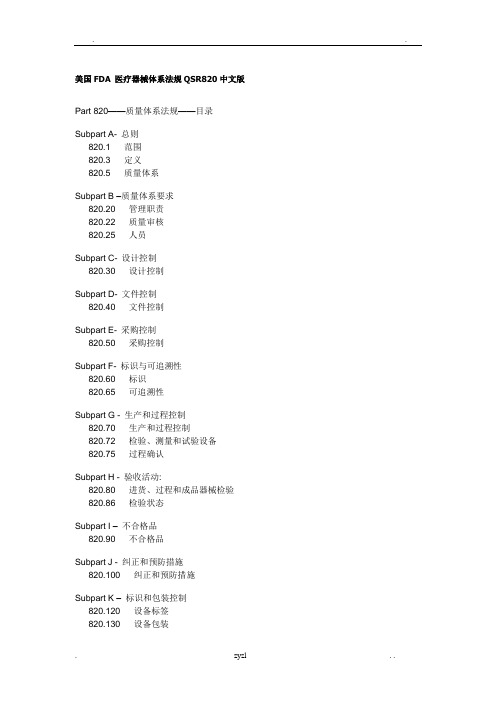
美国FDA 医疗器械体系法规QSR820中文版Part 820——质量体系法规——目录Subpart A- 总则820.1 范围820.3 定义820.5 质量体系Subpart B –质量体系要求820.20 管理职责820.22 质量审核820.25 人员Subpart C- 设计控制820.30 设计控制Subpart D- 文件控制820.40 文件控制Subpart E- 采购控制820.50 采购控制Subpart F- 标识与可追溯性820.60 标识820.65 可追溯性Subpart G - 生产和过程控制820.70 生产和过程控制820.72 检验、测量和试验设备820.75 过程确认Subpart H - 验收活动:820.80 进货、过程和成品器械检验820.86 检验状态Subpart I –不合格品820.90 不合格品Subpart J - 纠正和预防措施820.100 纠正和预防措施Subpart K –标识和包装控制820.120 设备标签820.130 设备包装Subpart L –搬运/储存/分销和安装820.140 搬运820.150 贮存820.160 分销820.170 安装Subpart L –记录820.180 记录的通用要求820.181 设备主要记录820.184 设备历史记录820.186 质量体系记录820.198 投诉文件Subpart M –服务820.200 服务Subpart N –统计技术820.250 统计技术Subpart A——总则Subpart A--General ProvisionsSec.820.1 范围Sec. 820.1 Scope.(a)适用性Applicability。
(1)本质量体系法规阐明了当前良好制造法规Current good manufacturing practice (CGMP)的要求。
本标准适用于所有预期用于人类的成品器械的设计、制造、包装、标识、储存、安装和服务中所使用的管理方法、设施和控制。
FDA 质量体系手册 第一章 质量体系法规

知识。
This manual covers the Quality System regulation and the basic Good Manufacturing Practices (GMP) requirements that all manufacturers and distributors must consider when they plan to manufacture medical devices, including medical device kits, trays or packs, for distribution in the United States. Model procedures and sample forms are also included in the manual to assist manufacturers. 本手册覆盖了所有制造商及分销商当他们计划在制造并且在美国分销医疗器械包括其套件, 托盘及包装时必须考虑的质量体系及 GMP 基本要求。本手册也包括流程模型,表格样本。
The Quality System regulation outlines the minimum elements of a system for designing and producing a medical device. Manufacturers of medical devices commonly find that their quality needs are broader than these basic elements because of the additional need to meet company quality claims as required by paragraph 501(c) of the Federal Food, Drug, and Cosmetic (FD&C) Act and to meet customer needs and requirements. 质量体系法规描述设计和生产医疗器械最少体系要素。医疗器械制造商通常会发现为了满足 其公司质量声明(如 FD&C 法案 501(c)章所要求)的额外要求和客户需求和要求,他们的 质量需求比这些基本要素(范围)更宽。 The DSMA staff and the Office of Compliance (OC) in the Center for Devices and Radiological Health (CDRH) provided valuable assistance in preparing this manual. CDRH 的 DSMA 工作人员及顺应性办公室(OC)在本手册的准备中提供了富有价值的辅助。
医疗器械质量管理体系手册
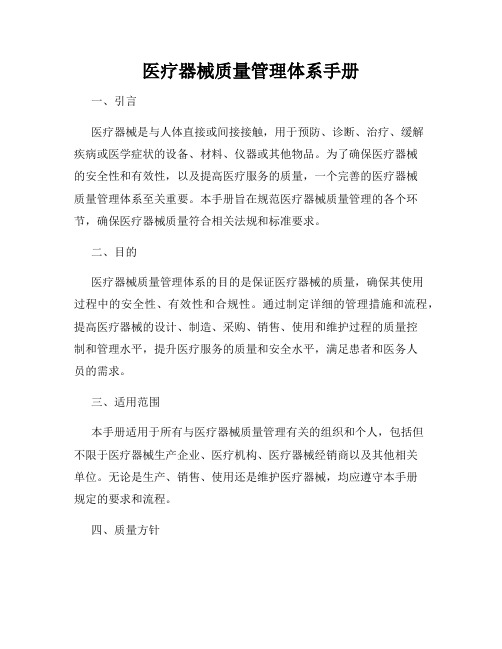
医疗器械质量管理体系手册一、引言医疗器械是与人体直接或间接接触,用于预防、诊断、治疗、缓解疾病或医学症状的设备、材料、仪器或其他物品。
为了确保医疗器械的安全性和有效性,以及提高医疗服务的质量,一个完善的医疗器械质量管理体系至关重要。
本手册旨在规范医疗器械质量管理的各个环节,确保医疗器械质量符合相关法规和标准要求。
二、目的医疗器械质量管理体系的目的是保证医疗器械的质量,确保其使用过程中的安全性、有效性和合规性。
通过制定详细的管理措施和流程,提高医疗器械的设计、制造、采购、销售、使用和维护过程的质量控制和管理水平,提升医疗服务的质量和安全水平,满足患者和医务人员的需求。
三、适用范围本手册适用于所有与医疗器械质量管理有关的组织和个人,包括但不限于医疗器械生产企业、医疗机构、医疗器械经销商以及其他相关单位。
无论是生产、销售、使用还是维护医疗器械,均应遵守本手册规定的要求和流程。
四、质量方针1. 安全第一:确保医疗器械的使用过程安全可靠,预防和控制医疗事故的发生。
2. 效果优先:追求医疗器械的高效治疗效果,提高患者的康复率和生活质量。
3. 合规合法:遵守相关法律法规和标准要求,保证医疗器械的合规性和合法性。
4. 持续改进:不断完善质量管理体系,提高医疗器械的质量水平和管理水平。
5. 用户满意:以用户需求为导向,提供符合用户期望的优质医疗器械和服务。
五、质量管理体系要求1. 领导层承诺:组织领导层应制定并贯彻质量方针,确保质量管理体系的有效运行。
领导层应着重关注医疗器械质量控制和改进的重要性,并提供必要资源和支持。
2. 职责分工:明确各级组织和个人在质量管理体系中的职责和权限,确保每个环节都有专业人员负责。
3. 风险管理:对医疗器械的设计、制造、销售、使用和维护等环节进行风险评估和控制,采取预防措施,减少潜在的安全风险。
4. 文件管理:建立合理的文件管理系统,包括相关政策、流程、规范、工作指南等,确保文件的及时更新和有效实施。
FDA质量体系规范-中文版 (QSR820)

FDA质量体系规范-中文版 (QSR820)(QSR820)1、1 概述§820、1 范围 (a)适用性 (1)在这个质量体系规范中描述了现行的生产管理规范的要求(CGMP)、本规范要求规定了所有医用器械成品在设计,制造,包装,标签,贮存,安装和服务中使用的方法,设施和控制、这些要求是为了确保医疗器械成品的安全和有效,并遵从美国食品,药品和化妆品法、本规范提出了适用于医疗器械成品制造商的基本要求、如果某制造商只进行本规范规定的一部分操作,而不进行其他操作,则该制造商仅需执行适用于他所进行操作的那些要求、有关Ⅰ类器械,设计控制仅按在§820、30(a)(2)中列出的要求进行、这个规范不适用于成品组件和零件的制造商,但鼓励这样的制造商使用规范的适当规定作为指导、人类血液制品和血液成分的制造商不属于本规范的管理范围,但属于606的管理范围、 (2) 这一规范的规定适用于本规范定义的医疗器械成品,即使用的对象是人的,在美国各州或领地,哥伦比亚特别区或波多黎哥联邦制造,进口或出口的器械成品、 (3)在本规范中,几次使用了短语”适当的地方”、当要求以”适当的地方”来限制时,如果制造商没有合理的理由来证明不适宜,就认为此要求是”适当的”、如果不贯彻”适当的”要求,就会导致产品达不到要求或制造商不能采取某些必要的正确措施、 (b) 范围这一的质量体系规范和增补在这一规范其他节的条文明确注明用于其他方面的条文除外、在不可能执行全部适用条文(包括这一节的和这一规范其他节的条文)的情况下,特定的运用于有问题器械的条文将取代其他一般的适用条文、 (c)权威性根据联邦法501,502,510,513,514,515,518,519,520,522,701,704,801,803, (21U、S、C、315,352,360,360c,360d,360e,360h,360i,360j,360l,371,374,38 1,383)建立和提出了820规范的权威性、如果没能执行适用规范,可能会导致产生伪劣器械, 根据法规501(h), 对这样的器械和未能执行规范的人都要进行处罚、 (d)外国制造商如果某制造商提供给美国的进口器械,拒绝接受FDA对外国设备进行是否执行本规范的检查,就会出现法规的801(a)节中的后果、用这样的设备生产出的任何器械,在设计,制造,包装, 标签,贮存,安装或服务方面,使用方法,设备和控制都未遵从法规的520(f)节和本规范的要求、根据法规501(h), 用这样的设备制造出来的器械都属于伪劣产品、 (e)豁免或更改 (1)任何希望豁免或更改执行某些器械质量体系要求的申请,都要遵从法规520(f)(2)的要求、申请豁免或更改的过程将依据这一规范§10、30的程序进行,即FDA的管理程序、以下地址可提供指导: 器械和放射卫生中心, 小制造商处(HFZ-220),1350 Piccard Dr、, Rockville, MD20850, U、S、A、电话:1-800-638-2041或1-301-443-6597, FAX301-443-8818、 (2)当FDA判定某种更改有益于公众健康时, 就会起草并认可这项更改、这种更改仅能在一段时间内维持有效, 即当器械仍能满足公众健康需要, 并且如果没有更改,器械不可能制造得非常有效的一段时间内、§820、3 定义 (a)法指的是美国食品,药品和化妆品法修正案(secs、201~903,52Stat、1040 et seq、, 修正版21U、S、C、321~394)、在法201中的全部定义都适用于本规定、 (b)投诉指的是以某些书面的,电子的或口头的形式表达意见, 认为在配发后的器械在鉴定,质量,耐久性,可靠性,安全性,有效性或性能方面有缺陷、 (c)组成指的是原材料,物质,小件,零件,软件,硬件,标签或有包装和标签的成品器械的零配件、 (d)控制编号指的是有区别的符号,如字母或数字的不同组合,或以原制造,包装,标签和分发的单个或批量成品的区别符号来分辨、 (e)设计历史文件(DHF)指的是描述某医疗器械成品设计过程的有关记录、(f)设计输入是指作为器械设计基础对器械的物理和特性要求、(g)设计输出是指各设计阶段的设计成果和最终的总设计成果、完成设计输出包括器械,包装和标签,器械主记录、 (h)设计评审是指依照依照文件进行广泛,系统的设计评审, 以评价设计要求的适当性,并评价设计达到这些要求的能力,查明问题所在、 (i)器械历史记录(DHR)是指医疗器械成品制造过程的记录、 (j)器械主记录(DMR)是指包括医疗器械成品的程序和规范的完满记录、 (k)建立是指定义,文件(书面的或电子的)和执行情况、 (l)器械成品是指适于使用或具有功能的器械或器械附件, 不论是否经过包装,贴标签或灭菌、 (m)批是指一种或几种组成或成品器械具有单一类型,型号,类别,尺寸,成分或软件版本,必须在相同条件下制造,并在规定的限度内具有相同的特征和质量、 (n)管理职责是指制造商的高级雇员有权建立或改变制造商的质量方针和质量体系、(o)制造商是指设计,制造,构造,装配或加工成品器械的人、制造商包括但不局限于那些从事灭菌,安装,再贴标签,再制造,再包装或Specification开发商和从事这些工作的外国实体的最初代理人、 (p)生产过程副产物是指促进生产过程所用的材料或物质,制造加工过程中的伴随组分或副产品,以残余物或混杂物的形式存在、 (q)不合格是指未达到特定的要求、 (r)产品是指组成,制造材料,加工过程中器械,成品器械及返回器械、 (s)质量是指使器械安全适用的总性质和特征,包括安全性和性能、 (t)质量审核是指在规定的时间间隔,以足够的次数,对制造商质量体系进行有组织的自主的检查,检验质量体系行为和结果是否执行质量体系程序,以保证有效地执行程序,达到质量体系目标、 (u)质量方针是指有关质量的机构方向和目标,是由负责的管理人员建立的、 (v)质量体系是指检查质量管理的组织机构,职责,程序,处理和资源、 (w)再加工是指对成品器械进行加工,调节,革新,再包装,再贮存,大大改变了成品器械的性能,安全性规范或用途、 (x)返工指的是对不合格产品采取某些措施,以使他在获准配发之前达到指定的DMR要求、 (y)规范是指生产,加工,服务或其他行为必须遵守的一些要求、 (z)有效性是指通过检查和提供客观证据来证明能始终满足特定的用途、 (1)过程确认是指通过客观的证据证明加工生产出的产物或产品始终达到预定的规范、 (2)设计确认是指通过客观的证据证明器械规范与使用者的需要和设计的用途相一致、 (aa)验证是指通过检查和提供客观证据来证明已经满足指定的要求、§820、5 质量体系各制造商应建立并保持一个质量体系,适合于他们设计或制造的医疗器械,并且达到本规范的要求、1、2 质量体系要求§820、20 管理职责 (a)质量方针管理职能机构应建立质量方针目标和质量承诺,并保证质量方针在企业各级人员中的理解,贯彻和持续执行、 (b)管理机构各制造商都应建立并维持一个适当的组织机构,以保证器械依照本规范进行设计和生产、 (1)职责和权限各制造商都应任命有相应职责,权限和能独立行使职权的人员负责管理,执行和评价质量体系、 (2)人员各制造商都应具备足够的合格人员,包括分派培训有素的人员从事管理,执行,评价和内部质量审核等工作,以达到本规范要求、(3)管理者代表管理职能机构应任命其中一员为管理者代表,并在文件中注明、管理者代表不论其他职责如何,必须履行下列职责和权力: i、确保按本规范要求有效地建立和保持、 ii、向管理机构汇报质量体系进行情况,供其讨论、 (c)管理评审管理职能机构应按照建立的程序,以足够的次数定期评审质量体系的适用性和有效性、以保证质量体系达到本规范要求和制造商建立的质量方针和目标,评审日期和结果应形成文件、 (d)质量策划各制造商应编制质量计划,确定与设计和制造的器械相关的质量实践,人员和措施,并建立达到质量要求的规划、 (e)质量体系程序各制造商应建立质量体系的各种程序和实施指南,并形成文件、§820、22 质量审核各制造商应建立质量审核的程序,并进行管理,以保证质量体系符合建立的质量体系要求,确定该质量体系的有效性、质量审核应由与审核事物无直接责任的人执行、若有必要时,应采取措施纠正错误措施,包括对有缺陷的事物进行再审核、管理机构对各质量审核的结果及再审核的情况进行复核、提供质量审核日期和结果及再审核的有关文件、§820、25 全体工作人员 (a)一般要求各制造商都应具有足够的工作人员,具备必需教育,背景,接受过培训并富有经验,以保证正确履行本节所要求的全部工作、 (b)培训各制造商应建立必需培训的程序,保证全部工作人员在经过培训后能胜任他们各自的职责,并提供与培训有关的文件、 (1)培训内容还包括使全体工作人员懂得由于错误执行指定工作可能会导致器械产生缺陷、 (2)使从事验证和确认工作的全体工作人员能预见可能会发生的缺陷和错误、1、3 设计控制§820、30 设计控制 (a)总则 (1)Ⅱ,III类器械的制造商,以及在本规范(a)(2)段列出的Ⅰ类器械制造商,应建立并保持控制器械设计的方法,以保证达到特定的要求、 (2)下列Ⅰ类器械也需要设计控制、 i、计算机软件的自动化机械、 ii、下面列出的器械: (b)设计和开发计划各制造商应建立并保持有关设计和开发行为的计划,并规定执行职责、计划应规定提供或输入设计和开发程序的不同组或行为的互换信息、对计划应进行检查,用现代化手段处理并证实设计和开发的进展、 (c)设计输入各制造商应建立并保持关于保证器械的设计要求适当的程序,以器械用途为主,包括使用者和病人的需要、该程序应包括关于不完善,不清楚或抵触要求的处理办法、设计输入要求应记录在文件中,并由指定的人进行检查和认可,并提供认可这些要求的日期和个人签名的文件、 (d)设计输出各制造商应建立并保持关于确定和提供设计输出文件的程序,并进行执行设计输入要求的适当评价、设计输出程序应包含或制定参照的认可标准,并保证那些设计输出是鉴定器械良好性能所必需的、设计输出应记录在文件中,在获准之前进行评审,并提供有关评审认可日期和签名的文件、(e)设计评审各制造商应建立并保持一套程序, 保证在器械设计开发的适当阶段,按计划评审设计结果,并提供正式文件、评审参加者应包括设计的专业人员对设计阶段负有责任的代表和与设计阶段五直接责任的人和必要的专家、设计评审的结果包括设计鉴定,评审人员和日期,都应记录在设计历史文件(DHF)中、 (f)设计验证各制造商应建立并保持验证器械设计的程序、设计验证应证明设计输出达到设计输入要求、设计验证的结果,包括设计方法的鉴定,验证人员和日期,都应当记录在DHF文件中、 (g)设计确认各制造商应建立并保持设计确认的程序、应在规定的操作条件下,对试制的单个,批量产品或等同物进行设计确认的确认、设计确认应保证器械满足使用者的需要,并具有预期用途,还应包括产品在实际或设想使用条件下的试验、设计确认还应包括软件确认及适当的时候的风险分析、有关设计确认的结果,包括对设计和设计方法的鉴定,执行人员和日期都应记录在DHF文件中、 (h)设计转换各制造商应建立并保持一套程序以确保器械设计正确性体现在一定的生产规范中、 (i)设计更改各制造商应建立并保持一套程序,对更改的设计在执行之前进行鉴定,提供有效性文件或适当的地方进行验证,评审和认可、 (j)设计历史文件各制造商应建立并保持各种类型器械的DHF、 DHF应包含或参照必要的原始记录,来证明设计开发过程与认可的设计计划一致,并遵守本规范要求、1、4 文件控制§820、40 文件控制各制造商应建立并保持本规范所要求的全部文件控制的程序、程序应提供下列内容: (a)文件认可和发布各制造商应在分发达到本规范要求的全部文件之前,委派专人检查适用性和认可情况、应提供有关认可文件的日期和个人签名的文件、达到本规范要求的文件适用于指定的,使用的或其他需要的地方,所有失效的文件应从使用条款中删除、 (b)文件更改更改文件应由执行原文件检查和认可的同一职能部门内的人进行检查和认可,除非有另外明确指定人选、认可的改动应及时地转达给有关人员、各制造商应保留更改文件的记录、更改记录应包括修改内容,相关文件的鉴定,认可人的签名,认可日期及更改生效的日期、1、5 采购控制§820、50 采购控制各制造商应建立并保持确保所有购买的或收到的产品和服务符合指定要求的程序、 (a)对供应商,承包商和咨询机构的评审各制造商应建立一套供应商,承包商和咨询机构必须达到的指定要求、各制造商应: (1)根据指定要求(包括质量要求),评价和选择潜在的供应商,承包商和咨询机构、评价应记录在文件中、 (2)根据评价结果,确定对产品,服务,供应商,承包商和咨询机构实施控制的方式和程度、 (3)建立和保持可接受的供应商,承包商和咨询机构的记录、 (b)采购资料各制造商应对采购的或收到的产品和服务建立并保留关于是否达到质量要求的资料、可能的话,应包括一份协议,关于供应商,承包商和咨询机构同意告知制造商,他们的产品或服务的改变,是制造商可以判断这些改变是否会影响成品器械的质量、采购资料应依照§820、40得到认可、1、6 标识和可追溯性§820、60 标识各制造商为防止混乱应建立并保持在接收,制造,交付和安装各阶段的产品标识程序、§820、65 可追溯性对于生产外科植入人体,支持或维持生命的器械制造商和依照制造商提供的使用说明正确使用时,如果器械运行失败可对使用者造成严重伤害,则应建立并保持对每个或每批产品都有唯一性标识的程序、程序应促进纠正错误措施、这种标识应包括在设计历史文件中、1、7 生产和过程控制§820、70 生产和过程控制 (a)总则各制造商应制定,实施,控制并监测生产过程,以保证器械遵守本规范、在制造加工过程中可能会发生违反规范的地方,制造商应建立并保持必须的生产过程控制的程序,生产过程控制应包括: (1)提供指导文件,标准操作程序(SOP’s),限定方法和生产控制方式;(2)在生产过程中监测和控制加工参数和产品特征; (3)应遵守的指定参考标准或编号; (4)加工和加工设备的认可; (5)工艺要求应阐述在工艺文件中或用通过鉴定和认可的代表性样品来表现、(b)生产和过程的改变各制造商应建立并保持改变规则,方法,加工或步骤的程序、这些改变在执行之前应被验证或在适当时依照§820、75使改变有效,这些行为均应记录在文件中、改变应依照§820、40得到认可、 (c)环境控制在有理由认为周围环境条件对产品质量有不利影响时,制造商应建立并保持适当控制环境条件的程序、应定期检查环境控制系统,以核实该系统,包括必需设备的适当性,并正发挥着良好作用、检查应记录在文件中、 (d)工作人员如果有理由认为工作人员和产品或环境的接触对产品质量有不利影响时,各制造商应建立并保持对工作人员的健康,卫生习惯,行为和衣着的要求、各制造商应保证在指定的环境下临时工作的其他人员接受适当的训练或由接受过训练的人进行监督、 (e)污染控制各制造商应建立并保持防止对产品质量有不良影响的物质污染设备或产品的程序、 (f)厂房应该设计适当厂房,具有足够的空间进行必须的操作,以防止混乱,并保证有序的操作、 (g)设备各制造商应保证在制造加工过程中使用的全部设备都达到指定要求,并经过适当设计,建造,放置和安装以利于保养,调试,清洁和使用、 (1)保养计划表各制造商应建立并保持调试,清洁和其他设备保养的计划表,以保证达到生产规范、保养行为,包括执行保养行为的日期和人员应记录在文件中、 (2)检查各制造商应依照建立的程序进行定期检查,以保证完成设备保养计划、检查日期和执行人员应记录在文件中、 (3)调试各制造商应将设备调整限度和允许公差的说明放在需要定期调试的设备商(或附近),或者从事这些调试的工作人员都备有说明、 (h)加工过程的副产物在有理由认为某加工过程的副产物对产品质量具有不利影响的情况下,各制造商应建立并保持使用和排除这种副产物的程序,以保证他被排除或减少到不会对产品质量有不利影响的量、排除或减少加工过程的副产物均应记录在在文件中、 (i)自动化处理对于生产或质量体系所用的计算机或自动化数据处理系统,制造商应依照已签订的协议书验证计算机软件是否具有预想的用途、修改的软件验证有效后方能批准和发布、验证过程和结果应记录在文件中、§820、72 检验,测量和实验设备 (a)检验,测量和实验设备的控制各制造商应保证全部检验,测量和实验设备,包括机械,自动化或电子的检查和试验设备,适合于期望的目的,并有能力生产有价值的产物、各制造商应建立并保持关于保证常规校准,检验,检查和保养设备的程序、该程序应包括操作,防护和存储设备的的规定,以保持实用的精密度和准确性、有关内容均应记录在文件中、 (b)校准校准程序应包括对准确度和精密度的准确说明和限值、当未达到准确度和精密度的限值时,应采取有效补救措施重建限值,并要评价是否对器械质量产生不利影响,有关内容要记录在文件中、(1)校准标准用于检验,测量和实验设备的校准标准应参照国家或国际标准、如果国家或国际标准不适用或不可得,制造商应使用一份自主的复制标准、如果没有可用的标准存在,制造商应建立并保持一份内部执行标准、 (2)校准记录设备鉴定,校准日期,每次校准的执行人及下一次校准的日期,均应记录在文件中、这些记录应放在每台设备上(或附近),或者使用设备和校准设备的人都备有记录、§820、75 过程确认 (a)当过程的结果不能被随后的检验和试验完全验证时,应建立高标准的保证和认可程序使加工过程确认、过程确认和结果,执行日期和执行人的签名,必要的设备,均应记录在文件中、 (b)各制造商应建立并保持关于检测和控制确认过程的过程参数的程序,以保证持续达到指定的要求、 (1)各制造商应保证由限定的人完成确认过程、 (2)确认过程,监测和控制方法及数据,执行日期,必要时完成确认过程的操作者或使用的主要设备均应记录在文件中、 (c)当过程确认发生变化或偏差时,制造商应检查并评价过程确认,必要时要使其再确认、有关内容应记录在文件中、1、8 认可行为§820、80 进货,加工过程和成品的认可 (a)总则各制造商应建立并保持认可的程序、认可包括检验,试验或其他验证行为、 (b)进货认可行为各制造商应建立并保持认可接受进厂产品的程序、对接受进厂的产品应进行检验,试验或其他验证以达到指定要求、认可和拒绝均应记录在文件中、 (c)加工过程中产品的认可行为适当的时候,各制造商应建立并保持保证加工过程中的产品达到指定要求的认可程序、这种程序在完成要求的检验,试验或其他验证行为,或者收到必须的认可证明之前,应保证加工过程中产品控制,并记录在文件中、 (d)成品认可行为各制造商应建立并保持认可成品的程序,以保证单个或各批成品达到认可标准、成品在认可以前应隔离放置,或以其他方式适当控制、成品在达到以下要求时,才可进行分发:完成DMR的要求;查阅相关数据和文件;指定专人批准许可并签名;注明批准日期、 (e)认可记录各制造商应将认可行为记录在文件中、这些记录应包括:执行的认可行为,执行日期,结果,执行认可行为的个人签名,使用的适当设备、这些记录应作为DHR的一部分内容、§820、86 认可状况各制造商应以适当的方式检验产品的认可状况,以指明产品是否符合认可标准、认可状况的检验应贯穿整个产品制造,包装,标签,安装和服务的过程,以保证只有通过认可的产品才能分发,使用或安装、1、9 不合格品§820、90 不合格品 (a)不合格品控制各制造商应建立并保持控制不合格产品的程序、程序中应写明不合格品的标识,记录,评价,隔离和处置、不合格评价包括确定是否需要调查并告知责任人或机构、评价和调查均应记录在文件中、 (b)不合格品的评审和处置 (1)各制造商应建立并保持评审和批准处置不合格品的职责的程序、程序应阐明评审和处置过程、对不合格品的处置过程应记录在文件中、文件还包括某不合格品是可用的依据及批准人签名、 (2)各制造商应建立并保持返工的程序,包括对不合格品返工之后的复试和复评,以保证产品达到现行的认可规范、返工和复评行为,包括确定返工对产品的不良影响,均应记录在DHR文件中、1、10 纠正和预防措施§820、100 纠正和预防措施各制造商应建立和保持实施纠正和预防措施的程序,程序应包括下列要求: (1)分析过程,操作,让步,质量审核报告,质量记录,服务记录,意见,返工产品或其他来源的数据,以查明导致不合格品或其他质量问题的现存和潜在原因、必要的时候,要适当使用统计学方法分析会再发生的质量问题、 (2)调查与生产过程和质量体系有关的不合格原因、 (3)确定纠正和防止再发生不合格品和其他质量问题的必须措施、 (4)验证纠正和防止措施是否有效,并对成品器械无不利影响、 (5)执行和记录修改的方法和程序,必须纠正和预防查明的。
医疗器械 质量手册 (通过FDA、NMPA、CE的审批,CE MDR版本 )
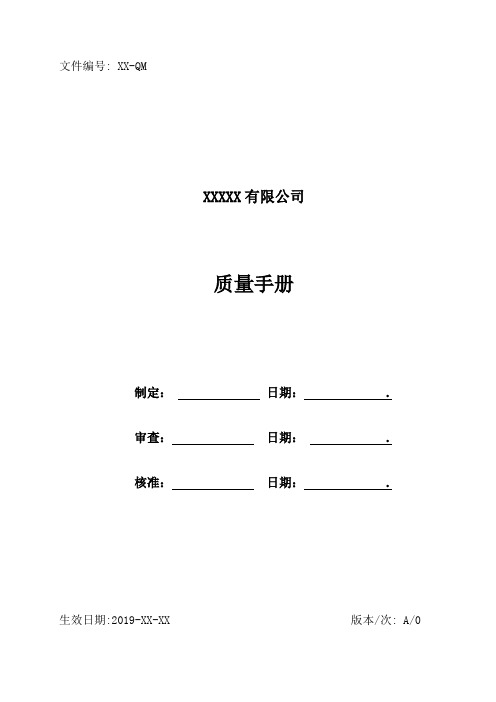
文件编号: XX-QMXXXXX有限公司质量手册制定:日期: .审查:日期: .核准:日期: . 生效日期:2019-XX-XX 版本/次: A/0文件封面修订页质量手册目录前言 (5)企业概况 (6)颁布令 (6)管理者代表任命书 (7)法规代表任命书 (9)0. 引言 (10)0.1 总则 (10)0.2 过程方法 (10)0.3 与其他标准的关系 (10)0.4 与其它管理体系的相容性 (11)1.范围 (11)1.1总则 (11)1.2应用 (11)2.引用标准及法规 (11)3.术语和定义 (12)4.质量管理体系 (12)4.1总要求 (12)4.2文件要求 (13)5.管理职责 (17)5.1管理承诺 (17)5.2以顾客为关注焦点 (17)5.3 质量方针 (17)5.4 策划 (17)5.5职责和权限与沟通 (18)5.6管理评审 (18)6.资源提供 (19)6.1资源提供 (19)6.2人力资源 (19)6.3基础设施 (20)6.4工作环境 (20)7.产品实现 (20)7.1产品实现的策划 (21)7.2 与顾客有关要求的确定 (21)7.3 设计和开发(本章节内容不适用于销往欧共体的产品) (22)7.4 采购 (25)7.5 生产和服务提供 (27)7.6监视和测量装置的控制 (29)8.测量、分析和改进 (30)8.1总则 (30)8.2监视和测量 (30)8.3不合格品的控制 (33)8.4数据分析 (34)8.5改进 (34)附件一:管理组织架构图 (36)附件二:质量管理系统过程 (36)附件三:质量管理体系职能分配表 (37)附件四质量管理程序文件目录 (37)附录五质量管理工作流程图 .................................................................... 错误!未定义书签。
前言XXXXX有限公司是一家从事一类和二类XXXXX治疗和护理产品的医疗器械生产商,我们一直在追求XXXXX 的路线。
美国FDA医疗器械法规体系介绍
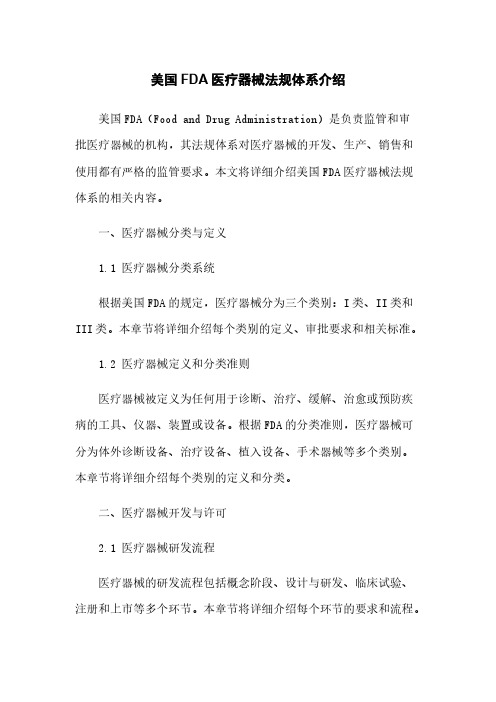
美国FDA医疗器械法规体系介绍美国FDA(Food and Drug Administration)是负责监管和审批医疗器械的机构,其法规体系对医疗器械的开发、生产、销售和使用都有严格的监管要求。
本文将详细介绍美国FDA医疗器械法规体系的相关内容。
一、医疗器械分类与定义1.1 医疗器械分类系统根据美国FDA的规定,医疗器械分为三个类别:I类、II类和III类。
本章节将详细介绍每个类别的定义、审批要求和相关标准。
1.2 医疗器械定义和分类准则医疗器械被定义为任何用于诊断、治疗、缓解、治愈或预防疾病的工具、仪器、装置或设备。
根据FDA的分类准则,医疗器械可分为体外诊断设备、治疗设备、植入设备、手术器械等多个类别。
本章节将详细介绍每个类别的定义和分类。
二、医疗器械开发与许可2.1 医疗器械研发流程医疗器械的研发流程包括概念阶段、设计与研发、临床试验、注册和上市等多个环节。
本章节将详细介绍每个环节的要求和流程。
2.2 510(k)许可510(k)许可是一种常见的医疗器械许可途径,要求新产品与现有同类产品具有相当的安全性和有效性。
本章节将详细介绍510(k)许可的要求和申请流程。
2.3 PMA许可PMA(Pre-Market Approval)许可适用于高风险医疗器械,要求提供充分的安全性和有效性证据。
本章节将详细介绍PMA许可的要求和申请流程。
三、医疗器械生产与质量管理3.1 QSR(Quality System Regulation)QSR是FDA的质量管理体系要求,适用于所有在美国市场销售的医疗器械制造商。
本章节将详细介绍QSR的各项要求和实施指南。
3.2 设计控制设计控制是医疗器械开发过程中的一个重要环节,要求制造商在设计阶段充分考虑安全性、可靠性和有效性等因素。
本章节将详细介绍设计控制的要求和实施指南。
3.3 验证与验证验证与验证是医疗器械生产过程中的关键环节,要求制造商验证设备和工艺的合格性,并对产品进行验证。
美国FDA_医疗器械体系法规QSR820中英文版之欧阳与创编

美国FDA 医疗器械体系法规QSR820中文版Part 820——质量体系法规——目录Subpart A- 总则820.1 范围820.3 定义 820.5 质量体系Subpart B –质量体系要求820.20 管理职责820.22 质量审核 820.25 人员Subpart C- 设计控制 820.30 设计控制Subpart D- 文件控制 820.40 文件控制Subpart E- 采购控制 820.50 采购控制Subpart F- 标识与可追溯性820.60 标识 820.65 可追溯性Subpart G - 生产和过程控制820.70 生产和过程控制820.72 检验、测量和试验设备 820.75 过程确认Subpart H - 验收活动: 820.80 进货、过程和成品器械检验 820.86 检验状态Subpart I –不合格品 820.90 不合格品Subpart J - 纠正和预防措施 820.100 纠正和预防措施Subpart K –标识和包装控制820.120 设备标签 820.130 设备包装Subpart L –搬运/储存/分销和安装820.140 搬运820.150 贮存820.160 分销 820.170 安装Subpart L –记录820.180 记录的通用要求820.181 设备主要记录820.184 设备历史记录820.186 质量体系记录 820.198 投诉文件Subpart M –服务 820.200 服务Subpart N –统计技术820.250 统计技术Subpart A——总则Subpart A--General Provisions Sec.820.1 范围Sec. 820.1 Scope. (a)适用性Applicability。
(1)本质量体系法规阐明了当前良好制造法规Current good manufacturing practice(CGMP)的要求。
QSIT质量体系检查指南
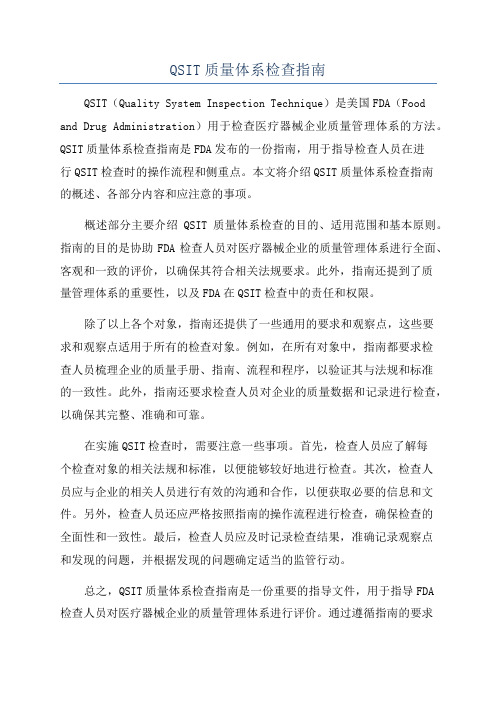
QSIT质量体系检查指南QSIT(Quality System Inspection Technique)是美国FDA(Food and Drug Administration)用于检查医疗器械企业质量管理体系的方法。
QSIT质量体系检查指南是FDA发布的一份指南,用于指导检查人员在进行QSIT检查时的操作流程和侧重点。
本文将介绍QSIT质量体系检查指南的概述、各部分内容和应注意的事项。
概述部分主要介绍QSIT质量体系检查的目的、适用范围和基本原则。
指南的目的是协助FDA检查人员对医疗器械企业的质量管理体系进行全面、客观和一致的评价,以确保其符合相关法规要求。
此外,指南还提到了质量管理体系的重要性,以及FDA在QSIT检查中的责任和权限。
除了以上各个对象,指南还提供了一些通用的要求和观察点,这些要求和观察点适用于所有的检查对象。
例如,在所有对象中,指南都要求检查人员梳理企业的质量手册、指南、流程和程序,以验证其与法规和标准的一致性。
此外,指南还要求检查人员对企业的质量数据和记录进行检查,以确保其完整、准确和可靠。
在实施QSIT检查时,需要注意一些事项。
首先,检查人员应了解每个检查对象的相关法规和标准,以便能够较好地进行检查。
其次,检查人员应与企业的相关人员进行有效的沟通和合作,以便获取必要的信息和文件。
另外,检查人员还应严格按照指南的操作流程进行检查,确保检查的全面性和一致性。
最后,检查人员应及时记录检查结果,准确记录观察点和发现的问题,并根据发现的问题确定适当的监管行动。
总之,QSIT质量体系检查指南是一份重要的指导文件,用于指导FDA检查人员对医疗器械企业的质量管理体系进行评价。
通过遵循指南的要求和操作流程,FDA可以更好地确保企业的质量管理体系符合相关法规要求,并保证医疗器械的安全、有效和可靠。
企业在接受QSIT检查时,也可以参考指南中的内容,加强与FDA的合作,提高质量管理水平,使其符合法规要求。
医疗器械质量体系手册 第二章 质量体系
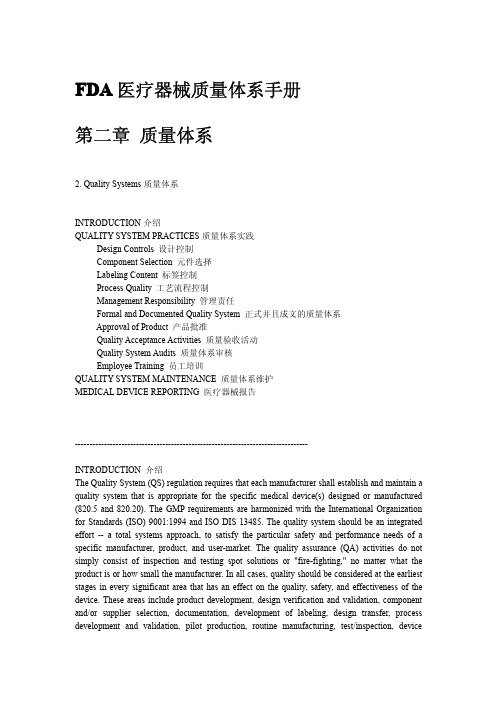
FDA医疗器械质量体系手册第二章质量体系2.Quality Systems质量体系INTRODUCTION介绍QUALITY SYSTEM PRACTICES质量体系实践Design Controls设计控制Component Selection元件选择Labeling Content标签控制Process Quality工艺流程控制Management Responsibility管理责任Formal and Documented Quality System正式并且成文的质量体系Approval of Product产品批准Quality Acceptance Activities质量验收活动Quality System Audits质量体系审核Employee Training员工培训QUALITY SYSTEM MAINTENANCE质量体系维护MEDICAL DEVICE REPORTING医疗器械报告--------------------------------------------------------------------------------INTRODUCTION介绍The Quality System(QS)regulation requires that each manufacturer shall establish and maintain a quality system that is appropriate for the specific medical device(s)designed or manufactured (820.5and820.20).The GMP requirements are harmonized with the International Organization for Standards(ISO)9001:1994and ISO DIS13485.The quality system should be an integrated effort--a total systems approach,to satisfy the particular safety and performance needs of a specific manufacturer,product,and user-market.The quality assurance(QA)activities do not simply consist of inspection and testing spot solutions or"fire-fighting,"no matter what the product is or how small the manufacturer.In all cases,quality should be considered at the earliest stages in every significant area that has an effect on the quality,safety,and effectiveness of the device.These areas include product development,design verification and validation,component and/or supplier selection,documentation,development of labeling,design transfer,process development and validation,pilot production,routine manufacturing,test/inspection,devicehistory record evaluation,distribution,service or repair,and plaints and,of course,favorable comments constitute customer feedback that may result in improvements in the device,labeling,packaging or quality system.质量体系法规要求每个制造商建立和保持一套对特定医疗器械设计或生产相适应的质量体系。
FDA质量体系规范-中文版 (QSR820)
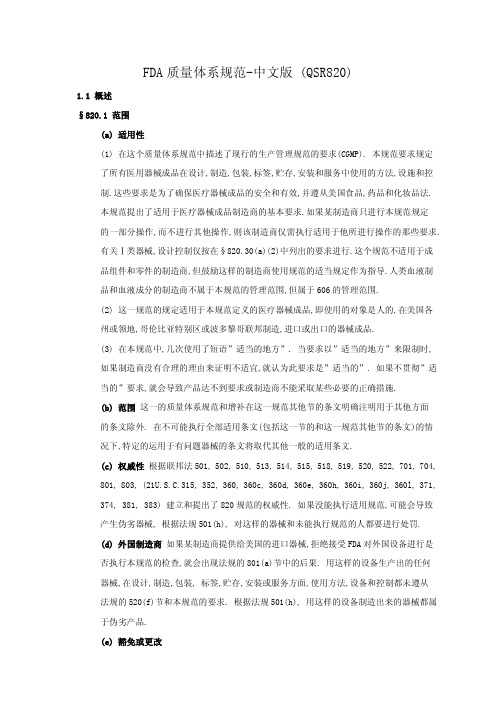
FDA质量体系规范-中文版 (QSR820)1.1 概述§820.1 范围(a) 适用性(1) 在这个质量体系规范中描述了现行的生产管理规范的要求(CGMP). 本规范要求规定了所有医用器械成品在设计,制造,包装,标签,贮存,安装和服务中使用的方法,设施和控制.这些要求是为了确保医疗器械成品的安全和有效,并遵从美国食品,药品和化妆品法.本规范提出了适用于医疗器械成品制造商的基本要求.如果某制造商只进行本规范规定的一部分操作,而不进行其他操作,则该制造商仅需执行适用于他所进行操作的那些要求.有关Ⅰ类器械,设计控制仅按在§820.30(a)(2)中列出的要求进行.这个规范不适用于成品组件和零件的制造商,但鼓励这样的制造商使用规范的适当规定作为指导.人类血液制品和血液成分的制造商不属于本规范的管理范围,但属于606的管理范围.(2) 这一规范的规定适用于本规范定义的医疗器械成品,即使用的对象是人的,在美国各州或领地,哥伦比亚特别区或波多黎哥联邦制造,进口或出口的器械成品.(3) 在本规范中,几次使用了短语”适当的地方”. 当要求以”适当的地方”来限制时,如果制造商没有合理的理由来证明不适宜,就认为此要求是”适当的”. 如果不贯彻”适当的”要求,就会导致产品达不到要求或制造商不能采取某些必要的正确措施.(b) 范围这一的质量体系规范和增补在这一规范其他节的条文明确注明用于其他方面的条文除外. 在不可能执行全部适用条文(包括这一节的和这一规范其他节的条文)的情况下,特定的运用于有问题器械的条文将取代其他一般的适用条文.(c) 权威性根据联邦法501, 502, 510, 513, 514, 515, 518, 519, 520, 522, 701, 704,801, 803, (21U.S.C.315, 352, 360, 360c, 360d, 360e, 360h, 360i, 360j, 360l, 371, 374, 381, 383) 建立和提出了820规范的权威性. 如果没能执行适用规范,可能会导致产生伪劣器械, 根据法规501(h), 对这样的器械和未能执行规范的人都要进行处罚.(d) 外国制造商如果某制造商提供给美国的进口器械,拒绝接受FDA对外国设备进行是否执行本规范的检查,就会出现法规的801(a)节中的后果. 用这样的设备生产出的任何器械,在设计,制造,包装, 标签,贮存,安装或服务方面,使用方法,设备和控制都未遵从法规的520(f)节和本规范的要求. 根据法规501(h), 用这样的设备制造出来的器械都属于伪劣产品.(e) 豁免或更改(1) 任何希望豁免或更改执行某些器械质量体系要求的申请,都要遵从法规520(f)(2)的要求. 申请豁免或更改的过程将依据这一规范§10.30的程序进行,即FDA的管理程序.以下地址可提供指导: 器械和放射卫生中心, 小制造商处(HFZ-220), 1350 Picca rd Dr., Rockville, MD20850, U.S.A. 电话: 1-800-638-2041或1-301-443-6597, FAX301-443-8818.(2) 当FDA判定某种更改有益于公众健康时, 就会起草并认可这项更改. 这种更改仅能在一段时间内维持有效, 即当器械仍能满足公众健康需要, 并且如果没有更改,器械不可能制造得非常有效的一段时间内.§820.3 定义(a)法指的是美国食品,药品和化妆品法修正案(secs.201~903, 52Stat.1040 et seq., 修正版21U.S.C.321~394). 在法201中的全部定义都适用于本规定.(b)投诉指的是以某些书面的,电子的或口头的形式表达意见, 认为在配发后的器械在鉴定,质量,耐久性,可靠性,安全性,有效性或性能方面有缺陷.(c)组成指的是原材料,物质,小件,零件,软件,硬件,标签或有包装和标签的成品器械的零配件.(d)控制编号指的是有区别的符号,如字母或数字的不同组合,或以原制造,包装,标签和分发的单个或批量成品的区别符号来分辨.(e)设计历史文件(DHF)指的是描述某医疗器械成品设计过程的有关记录.(f)设计输入是指作为器械设计基础对器械的物理和特性要求.(g)设计输出是指各设计阶段的设计成果和最终的总设计成果. 完成设计输出包括器械,包装和标签,器械主记录.(h)设计评审是指依照依照文件进行广泛,系统的设计评审, 以评价设计要求的适当性,并评价设计达到这些要求的能力,查明问题所在.(i)器械历史记录(DHR)是指医疗器械成品制造过程的记录.(j)器械主记录(DMR)是指包括医疗器械成品的程序和规范的完满记录.(k)建立是指定义,文件(书面的或电子的)和执行情况.(l)器械成品是指适于使用或具有功能的器械或器械附件, 不论是否经过包装,贴标签或灭菌.(m)批是指一种或几种组成或成品器械具有单一类型,型号,类别,尺寸,成分或软件版本,必须在相同条件下制造,并在规定的限度内具有相同的特征和质量.(n)管理职责是指制造商的高级雇员有权建立或改变制造商的质量方针和质量体系.(o)制造商是指设计,制造,构造,装配或加工成品器械的人. 制造商包括但不局限于那些从事灭菌,安装,再贴标签,再制造,再包装或Specification开发商和从事这些工作的外国实体的最初代理人.(p)生产过程副产物是指促进生产过程所用的材料或物质,制造加工过程中的伴随组分或副产品,以残余物或混杂物的形式存在.(q)不合格是指未达到特定的要求.(r)产品是指组成,制造材料,加工过程中器械,成品器械及返回器械.(s)质量是指使器械安全适用的总性质和特征,包括安全性和性能.(t)质量审核是指在规定的时间间隔,以足够的次数,对制造商质量体系进行有组织的自主的检查,检验质量体系行为和结果是否执行质量体系程序,以保证有效地执行程序,达到质量体系目标.(u)质量方针是指有关质量的机构方向和目标,是由负责的管理人员建立的.(v)质量体系是指检查质量管理的组织机构,职责,程序,处理和资源.(w)再加工是指对成品器械进行加工,调节,革新,再包装,再贮存,大大改变了成品器械的性能,安全性规范或用途.(x)返工指的是对不合格产品采取某些措施,以使他在获准配发之前达到指定的DMR要求.(y)规范是指生产,加工,服务或其他行为必须遵守的一些要求.(z)有效性是指通过检查和提供客观证据来证明能始终满足特定的用途.(1)过程确认是指通过客观的证据证明加工生产出的产物或产品始终达到预定的规范.(2)设计确认是指通过客观的证据证明器械规范与使用者的需要和设计的用途相一致.(aa)验证是指通过检查和提供客观证据来证明已经满足指定的要求.§820.5 质量体系各制造商应建立并保持一个质量体系,适合于他们设计或制造的医疗器械,并且达到本规范的要求.1.2 质量体系要求§820.20 管理职责(a)质量方针管理职能机构应建立质量方针目标和质量承诺,并保证质量方针在企业各级人员中的理解,贯彻和持续执行.(b)管理机构各制造商都应建立并维持一个适当的组织机构,以保证器械依照本规范进行设计和生产.(1)职责和权限各制造商都应任命有相应职责,权限和能独立行使职权的人员负责管理,执行和评价质量体系.(2)人员各制造商都应具备足够的合格人员,包括分派培训有素的人员从事管理,执行,评价和内部质量审核等工作,以达到本规范要求.(3)管理者代表管理职能机构应任命其中一员为管理者代表,并在文件中注明.管理者代表不论其他职责如何,必须履行下列职责和权力:i. 确保按本规范要求有效地建立和保持.ii. 向管理机构汇报质量体系进行情况,供其讨论.(c)管理评审管理职能机构应按照建立的程序,以足够的次数定期评审质量体系的适用性和有效性. 以保证质量体系达到本规范要求和制造商建立的质量方针和目标,评审日期和结果应形成文件.(d)质量策划各制造商应编制质量计划,确定与设计和制造的器械相关的质量实践,人员和措施,并建立达到质量要求的规划.(e)质量体系程序各制造商应建立质量体系的各种程序和实施指南,并形成文件.§820.22 质量审核各制造商应建立质量审核的程序,并进行管理,以保证质量体系符合建立的质量体系要求,确定该质量体系的有效性.质量审核应由与审核事物无直接责任的人执行.若有必要时,应采取措施纠正错误措施,包括对有缺陷的事物进行再审核.管理机构对各质量审核的结果及再审核的情况进行复核.提供质量审核日期和结果及再审核的有关文件.§820.25 全体工作人员(a)一般要求各制造商都应具有足够的工作人员,具备必需教育,背景,接受过培训并富有经验,以保证正确履行本节所要求的全部工作.(b)培训各制造商应建立必需培训的程序,保证全部工作人员在经过培训后能胜任他们各自的职责,并提供与培训有关的文件.(1)培训内容还包括使全体工作人员懂得由于错误执行指定工作可能会导致器械产生缺陷.(2)使从事验证和确认工作的全体工作人员能预见可能会发生的缺陷和错误.1.3 设计控制§820.30 设计控制(a) 总则(1) Ⅱ,III类器械的制造商,以及在本规范(a)(2)段列出的Ⅰ类器械制造商,应建立并保持控制器械设计的方法,以保证达到特定的要求.(2) 下列Ⅰ类器械也需要设计控制.i.计算机软件的自动化机械.ii.下面列出的器械:(b)设计和开发计划各制造商应建立并保持有关设计和开发行为的计划,并规定执行职责.计划应规定提供或输入设计和开发程序的不同组或行为的互换信息.对计划应进行检查,用现代化手段处理并证实设计和开发的进展.(c)设计输入各制造商应建立并保持关于保证器械的设计要求适当的程序,以器械用途为主,包括使用者和病人的需要.该程序应包括关于不完善,不清楚或抵触要求的处理办法.设计输入要求应记录在文件中,并由指定的人进行检查和认可,并提供认可这些要求的日期和个人签名的文件.(d)设计输出各制造商应建立并保持关于确定和提供设计输出文件的程序,并进行执行设计输入要求的适当评价.设计输出程序应包含或制定参照的认可标准,并保证那些设计输出是鉴定器械良好性能所必需的.设计输出应记录在文件中,在获准之前进行评审,并提供有关评审认可日期和签名的文件.(e)设计评审各制造商应建立并保持一套程序, 保证在器械设计开发的适当阶段,按计划评审设计结果,并提供正式文件.评审参加者应包括设计的专业人员对设计阶段负有责任的代表和与设计阶段五直接责任的人和必要的专家.设计评审的结果包括设计鉴定,评审人员和日期,都应记录在设计历史文件(DHF)中.(f)设计验证各制造商应建立并保持验证器械设计的程序.设计验证应证明设计输出达到设计输入要求.设计验证的结果,包括设计方法的鉴定,验证人员和日期,都应当记录在DHF文件中.(g)设计确认各制造商应建立并保持设计确认的程序.应在规定的操作条件下,对试制的单个,批量产品或等同物进行设计确认的确认.设计确认应保证器械满足使用者的需要,并具有预期用途,还应包括产品在实际或设想使用条件下的试验.设计确认还应包括软件确认及适当的时候的风险分析.有关设计确认的结果,包括对设计和设计方法的鉴定,执行人员和日期都应记录在DHF文件中.(h)设计转换各制造商应建立并保持一套程序以确保器械设计正确性体现在一定的生产规范中.(i)设计更改各制造商应建立并保持一套程序,对更改的设计在执行之前进行鉴定,提供有效性文件或适当的地方进行验证,评审和认可.(j)设计历史文件各制造商应建立并保持各种类型器械的DHF. DHF应包含或参照必要的原始记录,来证明设计开发过程与认可的设计计划一致,并遵守本规范要求.1.4 文件控制§820.40 文件控制各制造商应建立并保持本规范所要求的全部文件控制的程序.程序应提供下列内容:(a)文件认可和发布各制造商应在分发达到本规范要求的全部文件之前,委派专人检查适用性和认可情况.应提供有关认可文件的日期和个人签名的文件.达到本规范要求的文件适用于指定的,使用的或其他需要的地方,所有失效的文件应从使用条款中删除.(b)文件更改更改文件应由执行原文件检查和认可的同一职能部门内的人进行检查和认可,除非有另外明确指定人选. 认可的改动应及时地转达给有关人员.各制造商应保留更改文件的记录. 更改记录应包括修改内容,相关文件的鉴定,认可人的签名,认可日期及更改生效的日期.1.5 采购控制§820.50 采购控制各制造商应建立并保持确保所有购买的或收到的产品和服务符合指定要求的程序.(a)对供应商,承包商和咨询机构的评审各制造商应建立一套供应商,承包商和咨询机构必须达到的指定要求.各制造商应:(1)根据指定要求(包括质量要求),评价和选择潜在的供应商,承包商和咨询机构.评价应记录在文件中.(2)根据评价结果,确定对产品,服务,供应商,承包商和咨询机构实施控制的方式和程度.(3)建立和保持可接受的供应商,承包商和咨询机构的记录.(b)采购资料各制造商应对采购的或收到的产品和服务建立并保留关于是否达到质量要求的资料.可能的话,应包括一份协议,关于供应商,承包商和咨询机构同意告知制造商,他们的产品或服务的改变,是制造商可以判断这些改变是否会影响成品器械的质量.采购资料应依照§820.40得到认可.1.6 标识和可追溯性§820.60 标识各制造商为防止混乱应建立并保持在接收,制造,交付和安装各阶段的产品标识程序. §820.65 可追溯性对于生产外科植入人体,支持或维持生命的器械制造商和依照制造商提供的使用说明正确使用时,如果器械运行失败可对使用者造成严重伤害,则应建立并保持对每个或每批产品都有唯一性标识的程序.程序应促进纠正错误措施.这种标识应包括在设计历史文件中.1.7 生产和过程控制§820.70 生产和过程控制(a)总则各制造商应制定,实施,控制并监测生产过程,以保证器械遵守本规范. 在制造加工过程中可能会发生违反规范的地方,制造商应建立并保持必须的生产过程控制的程序,生产过程控制应包括:(1)提供指导文件,标准操作程序(SOP’s),限定方法和生产控制方式;(2)在生产过程中监测和控制加工参数和产品特征;(3)应遵守的指定参考标准或编号;(4)加工和加工设备的认可;(5)工艺要求应阐述在工艺文件中或用通过鉴定和认可的代表性样品来表现.(b)生产和过程的改变各制造商应建立并保持改变规则,方法,加工或步骤的程序.这些改变在执行之前应被验证或在适当时依照§820.75使改变有效,这些行为均应记录在文件中.改变应依照§820.40得到认可.(c)环境控制在有理由认为周围环境条件对产品质量有不利影响时,制造商应建立并保持适当控制环境条件的程序.应定期检查环境控制系统,以核实该系统,包括必需设备的适当性,并正发挥着良好作用.检查应记录在文件中.(d)工作人员如果有理由认为工作人员和产品或环境的接触对产品质量有不利影响时,各制造商应建立并保持对工作人员的健康,卫生习惯,行为和衣着的要求. 各制造商应保证在指定的环境下临时工作的其他人员接受适当的训练或由接受过训练的人进行监督.(e)污染控制各制造商应建立并保持防止对产品质量有不良影响的物质污染设备或产品的程序.(f)厂房应该设计适当厂房,具有足够的空间进行必须的操作,以防止混乱,并保证有序的操作.(g)设备各制造商应保证在制造加工过程中使用的全部设备都达到指定要求,并经过适当设计,建造,放置和安装以利于保养,调试,清洁和使用.(1)保养计划表各制造商应建立并保持调试,清洁和其他设备保养的计划表,以保证达到生产规范.保养行为,包括执行保养行为的日期和人员应记录在文件中.(2)检查各制造商应依照建立的程序进行定期检查,以保证完成设备保养计划.检查日期和执行人员应记录在文件中.(3)调试各制造商应将设备调整限度和允许公差的说明放在需要定期调试的设备商(或附近),或者从事这些调试的工作人员都备有说明.(h)加工过程的副产物在有理由认为某加工过程的副产物对产品质量具有不利影响的情况下,各制造商应建立并保持使用和排除这种副产物的程序,以保证他被排除或减少到不会对产品质量有不利影响的量.排除或减少加工过程的副产物均应记录在在文件中.(i)自动化处理对于生产或质量体系所用的计算机或自动化数据处理系统,制造商应依照已签订的协议书验证计算机软件是否具有预想的用途.修改的软件验证有效后方能批准和发布.验证过程和结果应记录在文件中.§820.72 检验,测量和实验设备(a)检验,测量和实验设备的控制各制造商应保证全部检验,测量和实验设备,包括机械,自动化或电子的检查和试验设备,适合于期望的目的,并有能力生产有价值的产物.各制造商应建立并保持关于保证常规校准,检验,检查和保养设备的程序.该程序应包括操作,防护和存储设备的的规定,以保持实用的精密度和准确性.有关内容均应记录在文件中.(b)校准校准程序应包括对准确度和精密度的准确说明和限值.当未达到准确度和精密度的限值时,应采取有效补救措施重建限值,并要评价是否对器械质量产生不利影响,有关内容要记录在文件中.(1)校准标准用于检验,测量和实验设备的校准标准应参照国家或国际标准.如果国家或国际标准不适用或不可得,制造商应使用一份自主的复制标准.如果没有可用的标准存在,制造商应建立并保持一份内部执行标准.(2)校准记录设备鉴定,校准日期,每次校准的执行人及下一次校准的日期,均应记录在文件中.这些记录应放在每台设备上(或附近),或者使用设备和校准设备的人都备有记录.§820.75 过程确认(a)当过程的结果不能被随后的检验和试验完全验证时,应建立高标准的保证和认可程序使加工过程确认.过程确认和结果,执行日期和执行人的签名,必要的设备,均应记录在文件中.(b)各制造商应建立并保持关于检测和控制确认过程的过程参数的程序,以保证持续达到指定的要求.(1)各制造商应保证由限定的人完成确认过程.(2)确认过程,监测和控制方法及数据,执行日期,必要时完成确认过程的操作者或使用的主要设备均应记录在文件中.(c)当过程确认发生变化或偏差时,制造商应检查并评价过程确认,必要时要使其再确认.有关内容应记录在文件中.1.8 认可行为§820.80 进货,加工过程和成品的认可(a)总则各制造商应建立并保持认可的程序.认可包括检验,试验或其他验证行为.(b)进货认可行为各制造商应建立并保持认可接受进厂产品的程序.对接受进厂的产品应进行检验,试验或其他验证以达到指定要求.认可和拒绝均应记录在文件中.(c)加工过程中产品的认可行为适当的时候,各制造商应建立并保持保证加工过程中的产品达到指定要求的认可程序.这种程序在完成要求的检验,试验或其他验证行为,或者收到必须的认可证明之前,应保证加工过程中产品控制,并记录在文件中.(d)成品认可行为各制造商应建立并保持认可成品的程序,以保证单个或各批成品达到认可标准.成品在认可以前应隔离放置,或以其他方式适当控制.成品在达到以下要求时,才可进行分发:完成DMR的要求;查阅相关数据和文件;指定专人批准许可并签名;注明批准日期.(e)认可记录各制造商应将认可行为记录在文件中.这些记录应包括:执行的认可行为,执行日期,结果,执行认可行为的个人签名,使用的适当设备.这些记录应作为DHR的一部分内容.§820.86 认可状况各制造商应以适当的方式检验产品的认可状况,以指明产品是否符合认可标准.认可状况的检验应贯穿整个产品制造,包装,标签,安装和服务的过程,以保证只有通过认可的产品才能分发,使用或安装.1.9 不合格品§820.90 不合格品(a)不合格品控制各制造商应建立并保持控制不合格产品的程序.程序中应写明不合格品的标识,记录,评价,隔离和处置.不合格评价包括确定是否需要调查并告知责任人或机构.评价和调查均应记录在文件中.(b)不合格品的评审和处置(1)各制造商应建立并保持评审和批准处置不合格品的职责的程序.程序应阐明评审和处置过程.对不合格品的处置过程应记录在文件中.文件还包括某不合格品是可用的依据及批准人签名.(2)各制造商应建立并保持返工的程序,包括对不合格品返工之后的复试和复评,以保证产品达到现行的认可规范.返工和复评行为,包括确定返工对产品的不良影响,均应记录在DHR文件中.1.10 纠正和预防措施§820.100 纠正和预防措施各制造商应建立和保持实施纠正和预防措施的程序,程序应包括下列要求:(1)分析过程,操作,让步,质量审核报告,质量记录,服务记录,意见,返工产品或其他来源的数据,以查明导致不合格品或其他质量问题的现存和潜在原因.必要的时候,要适当使用统计学方法分析会再发生的质量问题.(2)调查与生产过程和质量体系有关的不合格原因.(3)确定纠正和防止再发生不合格品和其他质量问题的必须措施.(4)验证纠正和防止措施是否有效,并对成品器械无不利影响.(5)执行和记录修改的方法和程序,必须纠正和预防查明的质量问题.(6)保证与质量问题或不合格品有关的信息能传达给那些直接负责保证该产品质量或预防此类问题的有关人员.(7)把查明的质量问题的相关信息和纠正及预防措施提交管理机构评审.(8)纠正和预防措施的全部措施及结果均记录在文件中.1.11 标签和包装的控制§820.120 器械标签各制造商应建立和保持控制标签的程序.(a)标签完整标签的印刷和应用应保持完整,并且在加工,贮存,搬运,分发和使用过程中的物品均应有标签.(b)标签审查指定专人审查标签的准确性,若适用应包括正确的有效期,控制编号,储存说明,搬运说明和其他附加的处理说明.(c)标签存储各制造商应以能够正确鉴别标签的方式储存标签,并防止混乱.(d)标签操作各制造商应控制标签和包装操作以防止混乱.标签和标签操作的单个或批。
美国FDA医疗器械质量体系手册 - 投诉处理

Medical Device Quality Systems ManualA Small Entity Compliance Guide First Edition (Supersedes theMedical Device Good Manufacturing Practices [GMP] Manual):ComplaintsINTRODUCTIONSection 820.3(b) of the Quality Systems regulation defines a complaint as "any written, electronic, or oral communication that alleges deficiencies related to the identity, quality, durability, reliability, safety, effectiveness, or performance of a device after it is released for distribution." All medical device manufacturers are subject to the complaint requirements in 21 CFR Part 820, Quality System regulation and to the reporting requirements in 21 CFR Part 803, Medical Device Reporting (MDR) regulation. A complaint is any indication of the failure of a device to meet customer or user expectations for quality or to meet performance specifications. A complaint may be lodged against any finished device that had been released for distribution. Any complaint involving the possible failure of a device, labeling, or packaging to meet any of its specifications is subject to the provisions of 21 CFR 820.198, Complaint Files.The sources of oral and written complaints are numerous. A manufacturer can receive this information via telephone, facsimile, written correspondence, sales representatives, service representatives, scientific articles, and FDA or internal analyses. Information will also be submitted by health care professionals, lay users, consumers, user facilities and distributors on the MedWatch Forms FDA 3500 and FDA 3500A.Manufacturers are required to review, evaluate, and, when appropriate, investigate complaints, establish and maintain written procedures describing the process used to perform these activities, and designate a responsible individual or entity to perform these tasks. Complaints concerning death, serious injury or malfunctions, as defined in the MDR regulation, shall be reported to FDA as discussed later. Manufacturers of any class of medical devices are never exempted from the Quality System regulation complaint requirements (820.198) nor the general record requirements (820.180) which permit FDA review and copying of these records. Complaint file requirements are necessary to make certain manufacturers have adequate quality systems for investigating complaints andtaking corrective action. Access to complaint files, device-related death and injury reports, and complaints about device defects enables FDA to determine if a manufacturer's quality system and corrective actions are adequate.Manufacturers can identify problems with device component, labeling and packaging quality by several methods. To meet all GMP requirements these identification methods should include a review and evaluation of all complaints, failed devices, and service or repair requests. Complaints and service or repair requests are important sources of feedback information for a quality system. Finished devices that are returned for service or repair may meet the complaint requirements identified in section 820.198; therefore, these service or repair requests shall be evaluated to determine if they are complaints. Service or repair data shall be reviewed [820.200(b)&(e)] to identify systematic problems and problems that may qualify as complaints. When these problems are identified they should be processed as complaints according to the requirements in 820.198.Complaint data, in conjunction with product audits, QA systems audits, operational analyses, inspection and test data, etc., is used by the quality assurance organization to:z identify poor performance in the overall quality system, particularly faulty design of devices, and faulty manufacturing processes;z aid in implementing solutions to these quality problems;z verify confidence in, and improve the performance of the quality system;z improve the safety and performance of devices;z reduce medical device reporting;z reduce costs and improve production schedules;z reduce employee confusion;z improve customer relations by reducing the frequency of problems, complaints, and recalls;and,z assure compliance with device regulations and consensus standards.Complaint Handling SystemAn effective complaint handling system is an extremely important part of any quality system. Even manufacturers who have not received complaints should be prepared to receive and process them. Manufacturers should understand that any complaint received on a product shall be evaluated and, if necessary, thoroughly investigated and analyzed, and corrective actions shall be taken. Theresults of this evaluation should lead to a conclusion regarding whether the complaint was valid, what the cause of the complaint was, and what action is necessary to prevent further occurrences. Complaints cannot be ignored. They are an excellent indicator of problems with the use, design, and/or manufacture of a product. A single complaint that is thoroughly investigated may lead a company to take remedial or corrective action. It may also take an ongoing analysis of numerous complaints before a trend is spotted that causes a company to initiate changes in their product, labeling, packaging or distribution.Using written procedures for handling complaints increases confidence that all complaints will be handled properly. Written procedures should be provided to employees to facilitate communication, maintain consistency, and reduce quality problems. Written procedures for the receiving, reviewing and evaluating of complaints by a formally designated unit shall be established and maintained in accordance with 820.198, Complaint Files, and 820.40, Document Controls, respectively. The procedures should include the need for complaints to be evaluated in accordance with 820.100, Corrective and Preventive Action.The complaint files shall be maintained in accordance with the general record keeping requirements of 820.180. All complaint files are to be retained for a period of time equivalent to the design and expected life of the device, but in no case less than 2 years from the date of release for commercial distribution bythe manufacturer. The written procedure should specify: authority; responsibilities; and the process to follow in receiving, reviewing, and investigating complaints. However, for very small manufacturers where division of work is minimal, and authorities and responsibilities are obvious, the GMP requirements as detailed in 820.198 in conjunction with appropriate forms may be sufficient as a protocol for handling complaints.Although FDA does not specify a standard complaint handling system, the GMP requirements do specify certain actions that shall be included in any system. Manufacturers shall: z document, review, evaluate, and file all complaints;z formally designate a unit or individual to perform these activities;z determine if an investigation is necessary;z record the reason if no investigation is made;z assign responsibility for deciding when not to investigate; and,z determine if the complaint requires an MDR report.Complaint ResponsibilityManufacturers shall formally assign responsibility for maintaining complaint files and conducting complaint investigations to individuals or an organizational unit. Under 820.25(b) it is the manufacturer's responsibility to ensure that personnel are properly trained to adequately perform their duties. These employees shall have the proper education and training to process complaints. Any difficulty noted in employees performing required tasks for proper complaint handling may be an indication that additional training is needed. Training shall be documented.The person(s) assigned to review complaints should have a thorough knowledge of the product line in order to make an informed, reasonable decision as to the severity and significance of a complaint and to decide whether an investigation is necessary. If it is decided that an investigation is not necessary, a record shall be made of the rationale used to arrive at this decision. The record must identify the individual responsible for making this decision.Executive management should ensure that adequate resources are provided, including trained personnel, to the designated complaint handling unit within the company. The activities of the unit should be assessed on a regular basis, and corrections made if necessary.MDR Reportable ComplaintsSection 820.198(c) specifically requires that any complaint involving the possible failure of a device, labeling, or packaging to meet its performance specifications shall be reviewed, evaluated, and investigated unless such investigation has already been performed for a similar complaint and another investigation is not necessary. Also, section 820.198(d) further specifies that any complaint that requires an MDR report shall be promptly reviewed, evaluated, and investigated by a designated individual(s), and shall be maintained in a separate portion of the complaint files or clearly identified. However, if maintained separately a manufacturer should duplicate these serious complaints in the regular complaint file to assure that any analysis performed by product is inclusive of all complaints. Analysis by appropriate statistical methodology where necessary is a means of identifying quality problems. A single event, of course, may also be an indicator of a quality problem.Complaint RecordsFDA does not specify a standard method for recording or retrieving complaint information. Each manufacturer should develop a method for maintaining records of complaints and investigations that: is functional and economical, meets company needs, and meets requirements ofthe Quality System regulation. A two sided form is suggested when using hard copy to record complaints. One side may be used to record complaint information such as:z sequential number of the complaint;z origin of the complaint;z customer information;z product information;z any corrective actions already taken;z details of the complaint;z and dates, signatures, assignments, etc.The other side may be used to record:z instructions;z investigations;z analyses;z conclusions;z corrective action with respect to the product and to the customer;z and dates, signatures, etc.A typical form is exhibited at the end of this chapter. The completed form should be stored in the complaint file which may be a physical or electronic file.Investigation RecordsThe designated unit or person(s) responsible for maintaining the complaint file(s) shall preparea written record of any investigations. This record shall include [820.198(e)]:(1) The name of the device;(2) The date the complaint was received;(3) Any device identification(s) and control number(s) used;(4) The name, address, and phone number of the complainant;(5) The nature and details of the complaint;(6) The dates and results of the investigation;(7) Any corrective action taken; and(8) Any reply to the complainant.Also, the investigation record of any complaint that is being reported to FDA in an MDR report shall include a determination of [820.198(e)]:(1) Whether the device failed to meet specifications;(2) Whether the device was being used for treatment or diagnosis; and(3) The relationship, if any, of the device to the reported incident or adverse event.Section 820.198(e) requires the record of investigation to include any reply to the complainant. Manufacturers should send a reply to each complainant as a courtesy, but more important to prevent further misuse, injury or other adverse situations from recurring. However, because of the nature of the complaint, there may be cases where a reply is not necessary. In such cases, the record should state that no reply was made and the reason for not replying. When the problem was caused by misuse, it is very important to advise the user to help prevent further misuse. Also, the manufacturer should determine if inadequate labeling may have lead to misuse.File Accessibility and LocationThe GMP requirement states in 820.180 that "All records required by this part shall be maintained at the manufacturing establishment or other location that is reasonably accessible to responsible officials of the manufacturer and to employees of the Food and Drug Administration designated to perform inspections." "All records" includes complaint files and records of investigations. For complaint processing, responsible officials are general managers, complaint processors, QA managers, R&D and process engineers, and others who receive, process, investigate, and correct problems associated with complaints. Complaint files shall be reasonably accessible to FDA for review and copying. FDA has clear authority under Section 704(e) of the Food, Drug, and Cosmetic Act to inspect and copy all records required under section 519 of this Act.The GMP requirement states that complaint files must be handled by a formally designated complaint unit. If the unit or individual(s) designated as responsible for investigating complaints is located away from the actual manufacturing site, the investigated complaint(s) and the record(s) of investigation shall be reasonably accessible to the manufacturing site. If a manufacturer's formally designated complaint unit is located outside of the United States, records required by this section shall be reasonably accessible in the United States at a location in the United States where the manufacturer's records are regularly kept or at the location of the original distributor.When devices are produced for a manufacturer by a contract manufacturer, the manufacturer should forward to the contractor copies of complaints and investigations that pertain to operations performed by the contractor. The contractor should maintain a complaint file and process complaints as discussed herein for the primary manufacturer.Relabelers, importers, and others who distribute under their own name should forward complaints to the actual manufacturers, including foreign manufacturers, who are usually in the best position to resolve complaints on their own products.Non-medical ComplaintsCertain manufacturers products may be used both as a medical device and for non-medical uses, for example lasers and motors. The complaints received from non-medical users do not necessarily have to be included in complaint files. However, if the non-medical product fails to meet specifications, then that report should be in the manufacturer's complaint file. This action would help assure compliance with 820.100, which requires identifying, recommending, or providing solutions for quality problems and verifying implementation of such solutions. The person receiving such complaints shall be trained [820.25(b)] to identify complaints that also affect those units used as medical devices.Complaint AnalysisTo facilitate detection of failure or defect trends, complaint files should be arranged in a manner that permits correlating present and past complaints for a particular product or product line. Thus, files are usually organized according to product or product lines. Manufacturers who do not organize complaint files by product or product line may have to search several files to find similar complaints or indications to identify problem trends. Complaints may be maintained in a computer file so that complaint data on a specific device or type of complaint can be readily accessed and analyzed. As appropriate, complaint analysis or their summaries should be included in the management review and the quality system [820.20(c)].DEVICE FAILURE ANALYSISManufacturers should process and analyze failed devices per 820.100. Section 820.100(a)(1) states that returned product is subject to corrective action. Failure analysis must be conducted by appropriately trained and experienced personnel [820.25(b)]. They should use a written procedure to assure that the process of device handling and analysis will not compromise the determination of the cause of the device failure. The failure investigation and analysis should determine the actual failure mechanism to the objective level necessary to correct the problem. When systematic failurehas been diagnosed and corrective action established, a manufacturer need not analyze all additional devices that are returned with the same symptoms.If a failure is determined to be related to safety and effectiveness, the deficiency should be determined, corrected and documented. If an investigation verifies a particular device deficiency and that this deficiency may exist in other products, the investigation should extend to determining its effect on other medical products.Any corrective or preventive action taken shall be done following the requirements in 820.100.FEEDBACK FOR QA SYSTEMThe more comprehensive a quality system is, the lower the probability of complaints occurring. However, in order for a quality assurance system to be dynamic or self correcting, data on quality problems from all sources should be fed back into the system. Complaints are a valuable source of data that can point to corrective actions.Feedback data should flow into all operations that could be affected by the data and should be used to aid in device and process design evaluation and/or redesign, and to aid in improving the overall quality system program.Regardless of the size of the formal quality system, the feedback data path in any company should be the same, that is, the data should flow into all affected operations even if some of these are not covered by the formal quality system or by FDA regulations.COMPLAINT SOURCESComplaints that shall be processed according to the GMP requirements may be received from: z customers by letter, credit memo, returned goods form, or phone;z a manufacturer's representative, or other employees;z the MedWatch voluntary reporting program;z a service or repair request;z journal articles; orz the FDA.Complaints from any source shall be equally addressed by and be processed according to the company complaint policy and procedure. The company should make certain that market, sales,engineering, manufacturing, regulatory, installation, and service personnel are trained to properly identify and report complaints. These employees shall be made aware of this requirement according to section 820.25(b).MEDICAL DEVICE REPORTINGIn addition to the GMP requirements covering complaint handling and failure investigations, device manufacturers shall also comply with the Medical Device Reporting (MDR) regulation, 21 CFR Part 803.Who Must ReportThe MDR regulation requires that all manufacturers of medical devices notify FDA when they become aware of a death or serious injury that may have been caused or contributed to by one of their marketed devices and/or any malfunction of one of their devices which, if it were to recur, would be likely to cause or contribute to a death or serious injury. These are the same complaints that the Quality System regulation requires a manufacturer to place in a separate portion of the complaint file or otherwise clearly identify [820.198(d)]. The MDR regulation is intended to supplement the Quality System regulation -- it is not meant to replace the GMP complaint and failure investigation requirements.When to ReportThere are specific time limits within which the MDR reports shall be made. Any report of a device-related death, serious injury and malfunction shall be submitted within 30 calendar days from becoming aware of an MDR reportable event. To meet these requirements, manufacturers shall have an information handling system to assure that data are screened to determine what shall be reported to FDA. This system shall also be able to follow up this information quickly and accurately in order to comply with the MDR regulation. Manufacturers which have a good system for processing complaint and failure investigations such as described in this chapter will have the organization and data processing capabilities to meet the MDR requirements.Manufacturers of medical devices are required to report a device related death, serious injury or malfunction to FDA using FDA Form 3500A, within 30 calendar days after becoming aware of the event. However, if the event necessitates remedial action to prevent an unreasonable risk of substantial harm to public health, then a report shall be submitted within 5 work days. Reports shallalso be submitted when FDA notifies a manufacturer that 5-day reports involving a particular type of medical device or type of event are required.The reporting process starts when an MDR reportable event is first recognized. Manufacturers are responsible for making sure their employees know how to recognize what may be reportable. Manufacturers should also emphasize that any employee may learn of an adverse event during a phone call, a sales visit, a professional conference, from correspondence received or fromservice/warranty orders.Individual Adverse Event ReportsThere are two types of individual adverse event reports that may be submitted by manufacturers. The 5 work day and 30 calendar day reports.The 5-day report (803.53) is for MDR reportable event(s) that require a remedial action to prevent an unreasonable risk of substantial harm to the public health or where FDA has specified that a 5-day report is needed. This situation may be identified by the manufacturer or FDA: z If the manufacturer identifies the event and initiates a remedial action to prevent an unreasonable risk of substantial harm to the public health, a 5-day report is submittedinstead of the 30-day report. Information not available within the five days should beprovided in a supplemental report.z If FDA identifies the event, the manufacturer will receive a written request directing them to file a 5-day report for all subsequent events of the same nature that involvesimilar devices for a specified time period. The FDA identification may be a result of itsreview of 30-day reports, inspection reports, user facility reports, etc.The 5-day period of reporting starts the day after any employee, who is a person with management or supervisory responsibilities over persons with regulatory, scientific, or technical responsibilities, or a person whose duties relate to the collection and reporting of adverse events, becomes aware that a reportable MDR event or events, from any information, including any analysis, necessitate remedial action to prevent an unreasonable risk of substantial harm to the public health.The MDR regulation defines remedial action as any action other than routine maintenance or servicing of a device where such action is necessary to prevent recurrence of a reportable event.Not all remedial actions need to be submitted as 5-day reports. Only remedial actions that are necessary to prevent an unreasonable risk of substantial harm to the public health shall be submitted.If a remedial action is taken, but it is not done to prevent an unreasonable risk of substantial harm to the public health a 5-day report is not required. A 30-day report, however, may be required.The discovery that a remedial action is necessary may be a direct result of one or more MDR reportable events occurring, or may be discovered through the performance of internal analyses using appropriate statistical or other acceptable methodologies for processing data.Actions taken to fix a single device involved in the MDR reportable event are not remedial actions.A 30-day report is required once a manufacturer receives or otherwise becomes aware of information that reasonably suggests that a device they have marketed:(1) has or may have caused or contributed to a death or serious injury; or(2) has malfunctioned and such device or similar device marketed by the manufacturer wouldbe likely to cause or contribute to a death or serious injury, if the malfunction were to recur.The 30-day period for reporting starts the day after receipt by any employee of information that reasonably suggests that an MDR reportable event has occurred. FDA expects manufacturers to train their employees to recognize that they have received information on an adverse event and to know to whom in the company to forward this information for an MDR evaluation.A manufacturer is NOT required to file an MDR report:z when it determines that a device related event did not occur, orz when it determines that the device was made by another manufacturer.For the latter instance, the regulation requires the manufacturer to forward whatever information they have to FDA with a cover letter explaining that they did not manufacture the device so that FDA can send it on to the correct manufacturer. In this case, a 3500A should not be completed. Manufacturers may also voluntarily send a copy of this information to the manufacturer they identify as being the actual manufacturer.Written MDR ProceduresIn addition to having general complaint handling procedures, the MDR regulation(803.17) requires manufacturers to develop, maintain and implement written MDR procedures that at a minimum:A. Set up internal systems for:z timely and effective identification, communication, and evaluation of any events that may be MDR reportable;z a standardized review process/procedure for determining when an event meets the criteria for reporting under the MDR regulation; andz timely transmission of a complete MDR report to FDA.B. Set up documentation and recordkeeping for:z information that was evaluated to determine if an event was MDR reportable;z all MDR reports and information submitted to FDA;z any information that was evaluated when preparing the annual certification report; and z systems that ensure access to information that facilitates timely follow up and inspection by FDA.The MDR procedures should be either incorporated in the overall complaint handling procedure or be a companion to it. In either case these MDR procedures shall be clearly identified. If a companion procedure, it shall be incorporated by reference in the overall procedure. This will assure that all complaints are properly evaluated for MDR reporting.Each manufacturer has certain discretion to determine the level of detail and depth of information that their written MDR procedures contain. FDA suggests that manufacturers provide policy and interpretation information regarding "typical" adverse events or product problems that may be MDR reportable. FDA also suggests that the procedures describe the investigation protocol that will be followed, e.g., two or three or four attempts will be made to contact the reporter either by phone, FAX or letter before an investigation is closed; that the complaint records will contain a concise but thorough description of the adverse event or product problem, that the complaint records will be legible, etc.MDR Event FilesEach event that requires a determination regarding its MDR reportability shall be documented in an MDR event file (MEF) (803.18). This MEF will be one of the bases for establishing compliance with the requirements of the MDR regulation. Files are to be accessible to FDA personnel for review and evaluation, be as complete as possible, and are to clearly document MDR related actions and decisions. The following information should be in the MEF to assure that it complies with the MDR requirements:a) The original or a copy of the initial record complaint/event. This record should includethe available information needed to complete the Form FDA 3500A. The record may bedocumentation of a telephone call, a letter or facsimile, a service report, documentsrelated to a lawsuit, a voluntary FDA 3500 received from a health care professional orconsumer, or mandatory FDA 3500A received from a User Facility and/or a Distributor,etc.b) Copies of any records documenting the manufacturer's attempts to follow-up and obtainmissing or additional information about the event. When information cannot be obtainedan explanation shall be made part of the file.c) Copies of any test reports, laboratory reports, service records and reports, records ofinvestigation, etc.d) Copies of all documentation involving the final assessment of the event, anydeliberations and/or decision making processes used to determine whether an MDRreport was or was not needed. When applicable, the final assessment should indicatewhat action, if any, the manufacturer has taken to assure that the cause of the event iscorrected or otherwise mitigated.e) Copies of all FDA 3500A forms submitted to FDA, when applicable. This includes acopy of any FDA 3500A forms received from User Facilities and Distributors.f) Documents verifying that the event has been evaluated in accordance with the applicablerequirements of the QS regulation, sections 820.100 and 820.198.g) References to any other relevant documents or information used during assessment. How To Maintain MDR Event FilesThe MEF can be written or electronic files. They may make reference to other information that was used during the investigational process, in lieu of copying and maintaining duplicates in the file. Any referenced material is to be made available to FDA personnel for review, copying and verification.Each MEF shall be retained for a period of two (2) years from the date of the event or a period of time equivalent to the expected life of the device, whichever is greater. Each MEF file shall be maintained for this period of time even if the device is no longer sold/distributed by the manufacturer.。
医疗器械质量管理体系手册
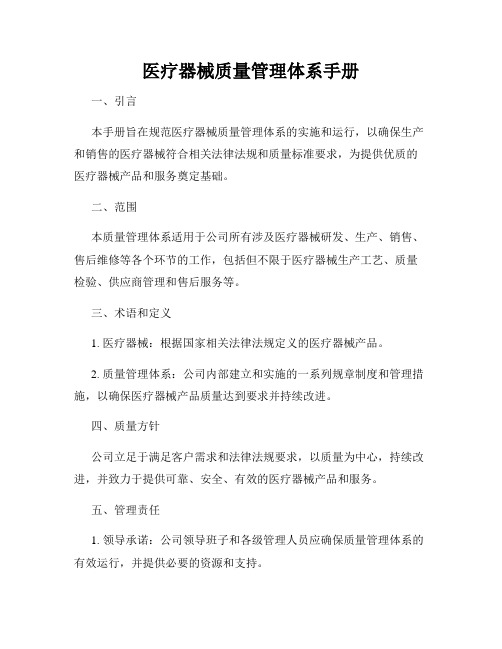
医疗器械质量管理体系手册一、引言本手册旨在规范医疗器械质量管理体系的实施和运行,以确保生产和销售的医疗器械符合相关法律法规和质量标准要求,为提供优质的医疗器械产品和服务奠定基础。
二、范围本质量管理体系适用于公司所有涉及医疗器械研发、生产、销售、售后维修等各个环节的工作,包括但不限于医疗器械生产工艺、质量检验、供应商管理和售后服务等。
三、术语和定义1. 医疗器械:根据国家相关法律法规定义的医疗器械产品。
2. 质量管理体系:公司内部建立和实施的一系列规章制度和管理措施,以确保医疗器械产品质量达到要求并持续改进。
四、质量方针公司立足于满足客户需求和法律法规要求,以质量为中心,持续改进,并致力于提供可靠、安全、有效的医疗器械产品和服务。
五、管理责任1. 领导承诺:公司领导班子和各级管理人员应确保质量管理体系的有效运行,并提供必要的资源和支持。
2. 质量目标:公司确定质量目标,确保其与公司战略一致,并通过绩效评估和定期审查来跟踪和监控目标的实现情况。
六、资源管理1. 人力资源:公司应建立合适的人力资源管理制度,确保员工具备必要的技能和知识,并通过培训和继续教育提高员工的职业素质。
2. 设备和环境:公司应保证生产和检验所需的设备符合相关法律法规和标准要求,并确保生产环境符合卫生和安全规范。
七、产品实施1. 设计和开发:公司应建立科学、系统的医疗器械设计和开发流程,并确保符合相关技术规范和法律法规要求。
2. 采购和供应商管理:公司应建立供应商评估和管理制度,确保从合格的供应商采购原材料和零部件,并与供应商建立长期稳定的合作关系。
3. 生产过程控制:公司应通过过程控制和监测来确保产品的一致性和符合性。
4. 质量检验:公司应建立完善的质量检验制度,对产品进行全面检验和测试,并确保符合相关质量标准和客户要求。
八、管理评审公司领导班子定期组织管理评审会议,对质量管理体系的有效性和适应性进行评估,并提出持续改进的意见和建议。
新版美国FDA医疗器械标准体系法规QSR中英文版

美国FDA 医疗器械体系法规QSR820汉字版Part 820——质量体系法规——目录Subpart A- 总则820.1 范围820.3 定义820.5 质量体系Subpart B –质量体系要求820.20 管理职责820.22 质量审核820.25 人员Subpart C- 设计控制820.30 设计控制Subpart D- 文件控制820.40 文件控制Subpart E- 采购控制820.50 采购控制Subpart F- 标识和可追溯性820.60 标识820.65 可追溯性Subpart G - 生产和过程控制820.70 生产和过程控制820.72 检验、测量和试验设备820.75 过程确定Subpart H - 验收活动:820.80 进货、过程和成品器械检验820.86 检验状态Subpart I –不合格品820.90 不合格品Subpart J - 纠正和预防方法820.100 纠正和预防方法Subpart K –标识和包装控制820.120 设备标签820.130 设备包装Subpart L –搬运/储存/分销和安装820.140 搬运820.150 贮存820.160 分销820.170 安装Subpart L –统计820.180 统计通用要求820.181 设备关键统计820.184 设备历史统计820.186 质量体系统计820.198 投诉文件Subpart M –服务820.200 服务Subpart N –统计技术820.250 统计技术Subpart A——总则Subpart A--General ProvisionsSec.820.1 范围Sec. 820.1 Scope.(a)适用性Applicability。
(1)本质量体系法规说明了目前良好制造法规Current good manufacturing practice (CGMP)要求。
本标准适适用于全部预期用于人类成品器械设计、制造、包装、标识、储存、安装和服务中所使用管理方法、设施和控制。
FDA Medical Device Quality Systems Manual中文简介
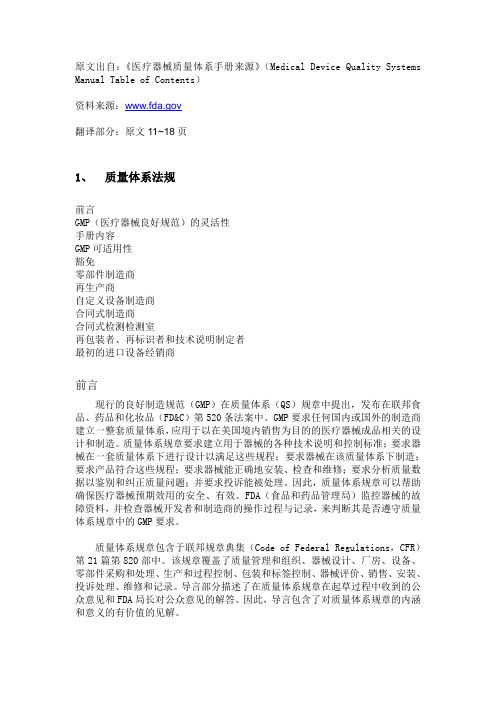
原文出自:《医疗器械质量体系手册来源》(Medical Device Quality Systems Manual Table of Contents)资料来源:翻译部分:原文11~18页1、质量体系法规前言GMP(医疗器械良好规范)的灵活性手册内容GMP可适用性豁免零部件制造商再生产商自定义设备制造商合同式制造商合同式检测检测室再包装者、再标识者和技术说明制定者最初的进口设备经销商前言现行的良好制造规范(GMP)在质量体系(QS)规章中提出,发布在联邦食品、药品和化妆品(FD&C)第520条法案中。
GMP要求任何国内或国外的制造商建立一整套质量体系,应用于以在美国境内销售为目的的医疗器械成品相关的设计和制造。
质量体系规章要求建立用于器械的各种技术说明和控制标准;要求器械在一套质量体系下进行设计以满足这些规程;要求器械在该质量体系下制造;要求产品符合这些规程;要求器械能正确地安装、检查和维修;要求分析质量数据以鉴别和纠正质量问题;并要求投诉能被处理。
因此,质量体系规章可以帮助确保医疗器械预期效用的安全、有效。
FDA(食品和药品管理局)监控器械的故障资料,并检查器械开发者和制造商的操作过程与记录,来判断其是否遵守质量体系规章中的GMP要求。
质量体系规章包含于联邦规章典集(Code of Federal Regulations,CFR)第21篇第820部中。
该规章覆盖了质量管理和组织、器械设计、厂房、设备、零部件采购和处理、生产和过程控制、包装和标签控制、器械评价、销售、安装、投诉处理、维修和记录。
导言部分描述了在质量体系规章在起草过程中收到的公众意见和FDA局长对公众意见的解答。
因此,导言包含了对质量体系规章的内涵和意义的有价值的见解。
质量体系规章参考本手册的附录。
GMP的灵活性制造商在制定其质量体系时应运用良好的判断,并应用那些适用于他们的特殊产品和操作的质量体系规章中的部分。
质量体系规章的第820.5节要求“每个制造商都应该建立和完善一个适用于特定设备的设计或制造,并且符合本节要求的质量体系规章。
FDA医疗器械质量体系手册
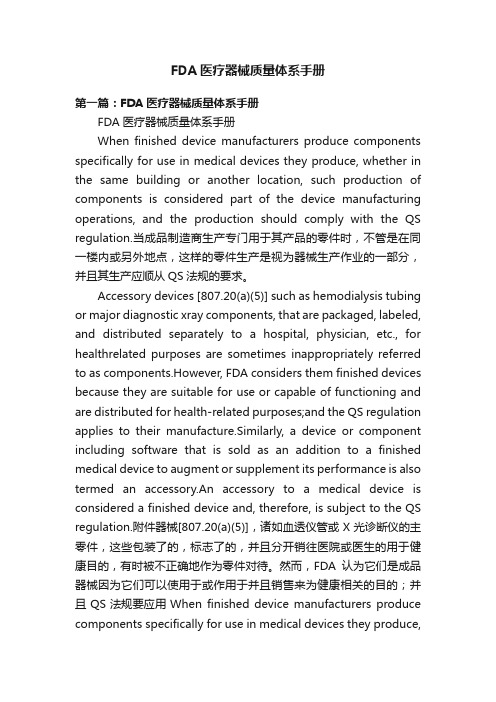
FDA医疗器械质量体系手册第一篇:FDA医疗器械质量体系手册FDA医疗器械质量体系手册When finished device manufacturers produce components specifically for use in medical devices they produce, whether in the same building or another location, such production of components is considered part of the device manufacturing operations, and the production should comply with the QS regulation.当成品制造商生产专门用于其产品的零件时,不管是在同一楼内或另外地点,这样的零件生产是视为器械生产作业的一部分,并且其生产应顺从QS法规的要求。
Accessory devices [807.20(a)(5)] such as hemodialysis tubing or major diagnostic xray components, that are packaged, labeled, and distributed separately to a hospital, physician, etc., for healthrelated purposes are sometimes inappropriately referred to as components.However, FDA considers them finished devices because they are suitable for use or capable of functioning and are distributed for health-related purposes;and the QS regulation applies to their manufacture.Similarly, a device or component including software that is sold as an addition to a finished medical device to augment or supplement its performance is also termed an accessory.An accessory to a medical device is considered a finished device and, therefore, is subject to the QS regulation.附件器械[807.20(a)(5)],诸如血透仪管或X光诊断仪的主零件,这些包装了的,标志了的,并且分开销往医院或医生的用于健康目的,有时被不正确地作为零件对待。
FDA医疗器械质量体系手册第三章设计控制

FDA医疗器械质量体系手册第三章设计控制3. Design Controls3 设计控制INTRODUCTION引言Coverage覆盖范围QUALITY SYSTEM质量体系Personnel Training人员培训DESIGN AND DEVELOPMENT PLANNING设计和开发计划Interface沟通Structure of Plans计划的结构DESIGN INPUT设计输入Input Checklists输入检查表DESIGN REVIEW设计评审Combination Devices载药器械Preparation For Reviews评审准备Why Design Reviews设计评审的原因Types Of Design Review Meetings设计审核会议的类型Design Review Requirements设计评审要求End Of Initial Design初步设计的结束DESIGN OUTPUT设计输出Documenting Design Output设计输出的记录成文Acceptance Criteria确认条件Design Output Approval设计输出审批DESIGN VERIFICATION AND V ALIDATION设计确认和验证Design Evaluation versus Specifications根据规格进行设计评估Software Validation软件验证Labeling Verification标识确认DESIGN TRANSFER设计转移DESIGN CHANGES设计变更DESIGN HISTORY FILE设计历史文件EXHIBITS示例Design Input Requirements Procedure设计输入规定程序INTRODUCTION引言The Safe Medical Devices Act of 1990 added design validation requirements to the GMP requirements in section 520(f) of The Act. Section 820.30 of the Quality System (QS) regulation lists the design control requirements that manufacturers should satisfy to be in compliance. This chapter describes design controls and provides guidance to assist manufacturers in complying with design control requirements."Design Control Guidance for Medical Device Manufacturers" is another document that may assist manufacturers in understanding the intent of the design control requirements. This manual interprets the language of the QS regulation and explains the underlying concepts in practical terms. "Do It By Design: An Introduction to Human Factors in Medical Devices" is a document that contains background information about human factors as a discipline, describes and illustrates device problems and discusses human factors principles and methods as a part of the design control system. Both of these manuals are possible resources for manufacturers who are either developing or improving their design control system. These manuals are also available through DSMA.一九九零年的《安全医疗器械法案》在法案的520(f)部分的GMP 规定中加入了设计验证规定。
- 1、下载文档前请自行甄别文档内容的完整性,平台不提供额外的编辑、内容补充、找答案等附加服务。
- 2、"仅部分预览"的文档,不可在线预览部分如存在完整性等问题,可反馈申请退款(可完整预览的文档不适用该条件!)。
- 3、如文档侵犯您的权益,请联系客服反馈,我们会尽快为您处理(人工客服工作时间:9:00-18:30)。
FDA医疗器械质量体系手册When finished device manufacturers produce components specifically for use in medical devices they produce, whether in the same building or another location, such production of components is considered part of the device manufacturing operations, and the production should comply with the QS regulation.当成品制造商生产专门用于其产品的零件时,不管是在同一楼内或另外地点,这样的零件生产是视为器械生产作业的一部分,并且其生产应顺从QS法规的要求。
Accessory devices [807.20(a)(5)] such as hemodialysis tubing or major diagnostic xray components, that are packaged, labeled, and distributed separately to a hospital, physician, etc., for healthrelated purposes are sometimes inappropriately referred to as components. However, FDA considers them finished devices because they are suitable for use or capable of functioning and are distributed for health-related purposes; and the QS regulation applies to their manufacture. Similarly, a device or component including software that is sold as an addition to a finished medical device to augment or supplement its performance is also termed an accessory. An accessory to a medical device is considered a finished device and, therefore, is subject to the QS regulation.附件器械[807.20(a)(5)],诸如血透仪管或X光诊断仪的主零件,这些包装了的,标志了的,并且分开销往医院或医生的用于健康目的,有时被不正确地作为零件对待。
然而,FDA认为它们是成品器械因为它们可以使用于或作用于并且销售来为健康相关的目的;并且QS法规要应用When finished device manufacturers produce components specifically for use in medical devices they produce, whether in the same building or another location, such production of components is considered part of the device manufacturing operations, and the production should comply with the QS regulation.当成品制造商生产专门用于其产品的零件时,不管是在同一楼内或另外地点,这样的零件生产是视为器械生产作业的一部分,并且其生产应顺从QS法规的要求。
Accessory devices [807.20(a)(5)] such as hemodialysis tubing or major diagnostic xray components, that are packaged, labeled, and distributed separately to a hospital, physician, etc., for healthrelated purposes are sometimes inappropriately referred to as components. However, FDA considers them finished devices because they are suitable for use or capable of functioning and are distributed for health-related purposes; and the QS regulation applies to their manufacture. Similarly, a device or component including software that is sold as an addition to a finished medical device to augment or supplement its performance is also termed an accessory. An accessory to a medical device is considered a finished device and, therefore, is subject to the QS regulation.附件器械[807.20(a)(5)],诸如血透仪管或X光诊断仪的主零件,这些包装了的,标志了的,并且分开销往医院或医生的用于健康目的,有时被不正确地作为零件对待。
然而,因为它们可以使用于或作用于并且销售来为健康相关的目的,FDA认为它们是成品器械;并且QS法规要应于其生产。
同样的,装置或零件包括软件是作为成品医疗器械的附加部分销售的,以增加或补充其性能,也作为附件器械对待。
既然医疗器械的附件是作为成品来对待,因而受QS法规制约。
A remanufacturer is any person who processes, conditions, renovates, repackages restores or does any other act to a finished device which has been previously distributed to significantly change the finished device's performance or safety specifications or intended use from that established by the original finished device manufacturer. Remanufacturers are considered manufacturers. As such, these manufacturers are subject to inspection by FDA and shall meet the applicable requirements of the medical device QS regulation. These manufacturers shall establish and implement quality systems to assure the safety and effectiveness of the devices that are distributed. Such activities include drafting of master records, rebuilding per the master records, inspection and testing, calibration of measurement equipment, control of components, updating of labeling, processing of complaints, and any other GMP requirement applicable to the activities being performed.再加工者是对成品器械进行加工、翻新、整修、重新包装修复品或任何其他行为来明显改变该经过销售的由原来的成品制造商所设定的成品器械的性能、安全指标或使用目的的人。
再加工者也被视为制造商。
同样地,这些制造商要接受FDA的检查,并满足医疗器械质量体系规章可适用的要求。
这些制造商也应建立和实施质量体系,确保其销售的器械的安全和有效。
这样的行动包括器械主记录的起草、对照器械主记录重制造、检查和测试、测量仪器的校准、部件的控制、标签的更新、投诉的处理和其他在其活动中可适用的GMP 要求。
Remanufacturers are also required to comply with the labeling requirements of 21 CFR 801.1(c). This labeling regulation requires that where the person or manufacturer named on the label of the device is not the original manufacturer, the name shall be qualified by an appropriate phrase which reveals the connection that person has with the device, e.g., remanufactured by XYZ Company.再加工者同时也被要求遵守联邦法规第21 篇第801.1(c)节中对标签所作的规定。
该标签规章要求器械标签的制造商名字不是初始制造商,并且名称应选用那些揭示其与器械的关系的合适的措词,譬如,由某某公司再加工。
Custom Device Manufacturers定制器械制造商Section 520(b) of the FD&C Act and the IDE regulation (21 CFR Part 812) define a custom device. Custom devices are exempt from certain statutory requirements. For example, manufacturers of custom devices are not required to comply with premarket approval requirements (Section 515) and are exempt from premarket notification requirements [Section 510(k)]. Custom devices are NOT exempt from the GMP requirements. Current FDA policy, however, is to not inspect manufacturers of custom devices. Manufacturers of custom devices should comply with the GMP requirements while considering the flexibility allowed.食品、药品和化妆品法的第520(b)节和联邦法规第21篇812.3(b)篇研究用器械豁免(IDE)法规都对定制式器械进行了定义。
